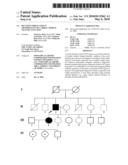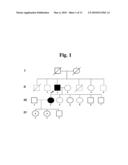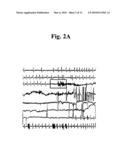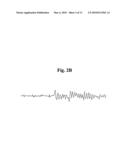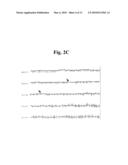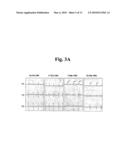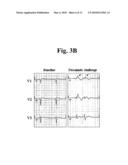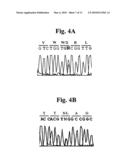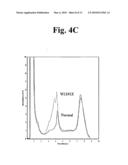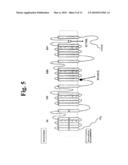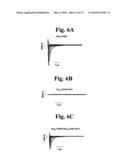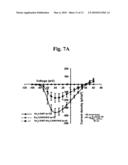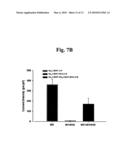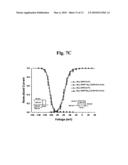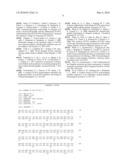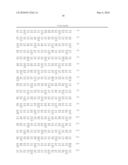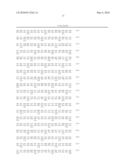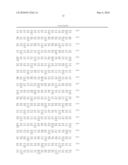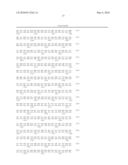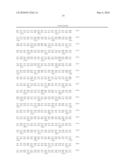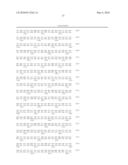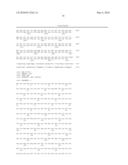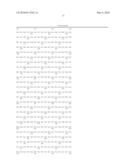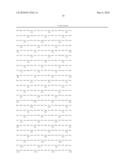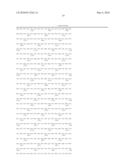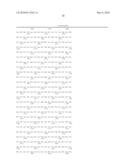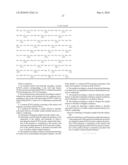Patent application title: Mutation Implicated in Abnormality of Cardiac Sodium Channel Function
Inventors:
Yang Soo Jang (Seoul, KR)
Yang Soo Jang (Seoul, KR)
Sung Soon Kim (Seoul, KR)
Sung Soon Kim (Seoul, KR)
Sungjoo Kim Yoon (Seoul, KR)
Dong-Jik Shin (Seoul, KR)
Assignees:
Industry-Academic Cooperation Foundation Yonsei University
INDUSTRY-ACADEMIC COOPERATION FOUNDATION THE CATHOLIC UNIVERSITY OF KOREA
IPC8 Class: AC12Q168FI
USPC Class:
435 6
Class name: Chemistry: molecular biology and microbiology measuring or testing process involving enzymes or micro-organisms; composition or test strip therefore; processes of forming such composition or test strip involving nucleic acid
Publication date: 2010-05-06
Patent application number: 20100112562
Claims:
1. An isolated nucleic acid molecule encoding a mutant SCN5A protein
corresponding to the wild type human SCN5A protein set forth in SEQ ID
NO:2, wherein the mutant SCN5A protein has a W1191X mutation.
2. The isolated nucleic acid molecule according to claim 1, wherein the nucleic acid molecule has the sequence corresponding to that of the wild type human SCN5A cDNA set forth in SEQ ID NO:1 with a G to A substitution at nucleotide 3573.
3. A mutant SCN5A protein consisting of the amino acid sequence set forth in SEQ ID NO:2.
4. A method for detecting a cardiac disease or disorder associated with loss of cardiac sodium channel function in a subject, comprising:(a) obtaining a biological sample from the subject; and(b) detecting in said biological sample the presence or the expression of the nucleic acid molecule of claim 1 encoding the mutant SCN5A protein, wherein the detection of the presence or expression of the nucleic acid molecule encoding the mutant SCN5A protein is indicative of the cardiac disease or disorder associated with loss of cardiac sodium channel function.
5. The method according to claim 4, wherein the detecting is carried out by contacting the biological sample to an antibody specific to a mutant SCN5A protein consisting of the amino acid sequence set forth in SEQ ID NO:2.
6. The method according to claim 4, wherein the detecting is carried out by an amplification reaction, hybridization reaction or sequencing.
7. The method according to claim 4, wherein the cardiac disease or disorder is Brugada syndrome, long QT syndrome, atrial arrhythmia or progressive conduction disease.
8. The method according to claim 5, wherein the cardiac disease or disorder is Brugada syndrome.
9. A system for detecting a cardiac disease or disorder associated with loss of cardiac sodium channel function in a subject, comprising:means for obtaining a biological sample from the subject; andmeans for detecting in said biological sample the presence or the expression of the nucleic acid molecule of claim 1 encoding the mutant SCN5A protein, wherein the detection of the presence or expression of the nucleic acid molecule encoding the mutant SCN5A protein is indicative of the cardiac disease or disorder associated with loss of cardiac sodium channel function.
Description:
CROSS-REFERENCE TO RELATED APPLICATION
[0001]This is a non-provisional of U.S. Provision Application 61/023,423, filed on Jan. 24, 2008 in the USPTO, the disclosure of which is incorporated herein by reference.
BACKGROUND
[0002]The present invention relates to a novel mutation in the SCN5A gene associated with loss of cardiac sodium channel function.
RELATED ART
[0003]Brugada syndrome (BS) is an inherited electrical cardiac disorder characterized by an incomplete right bundle branch block (RBBB), a typical electrocardiogram (ECG) pattern of ST-segment elevation in the right precordial leads V1 to V3, a structurally normal heart, and a highly increased risk of sudden cardiac death as a result of polymorphic ventricular tachycardia (VT) or ventricular fibrillation (VF) (Brugada and Brugada, 1992; Antzelevitch et al., 2002). This disorder is not related to acute ischemia, electrolyte abnormalities or structural heart diseases (Wilde et al., 2002). BS is a familial disease with autosomal dominant transmission. While BS has been observed worldwide, it is more common in Southeast Asian and Japanese populations (Nademanee et al., 1997) and, interestingly, manifests much more frequently in men than women (Priori et al., 2002). The mean age at onset of clinical events (syncope or cardiac arrest) is 30-40 years, although severe forms with earlier onset and even neonatal expression have been reported (Priori et al., 2000).
[0004]The cardiac sodium channel is responsible for the generation of the rapid upstroke of the cardiac action potential and plays a key role in cardiac impulse propagation (Balser, 1999). Sodium channels are heterodimeric assemblies composed of a pore forming α-subunit and several regulatory β-subunits. The α-subunit consists of four homologous domains (DI-DIV). Each domain contains six transmembrane segments (S1-S6) connected by short linking intracellular segments (Cohen and Barchi, 1992). The SCN5A gene that encodes the α-subunit of the human cardiac voltage-gated sodium channel (Nav1.5) (Antzelevitch et al., 2002) is located on chromosome 3p21 and consists of 28 exons spanning approximately 80 kb (Wang et al., 1996). While several candidate genes are considered plausible, thus far BS has been linked only to mutations in SCN5A. Understanding the molecular and cellular mechanisms leading to BS remains limited, and, to date, a minority (approximately 20%) of patients with BS have been found to carry a mutation in this gene (Priori et al., 2000). Several reports have estimated the prevalence of Brugada-type ECG changes at approximately 0.1-0.7% in the general population worldwide (Hermida et al., 2000; Matsuo et al., 2001). Genetic studies have demonstrated that some cases of BS and chromosome 3-linked long-QT syndrome (LQT3) are allelic variations of SCN5A.
[0005]To date, several dozen SCN5A mutations in patients with BS have been identified. Three categories of SCN5A mutations have been reported in BS: missense, splice-donor, and frameshift (Chen et al., 1998; Desch nes et al., 2000; Naccarelli et al., 2001). Functional analyses have revealed that most SCN5A mutations lead to a loss of function of cardiac sodium channels by reducing the sodium current (INa) available during the early phase of the cardiac action potential (Balser, 1999; Baroudi et al., 2000). Because INa plays an important role in human heart excitation and contraction, functional variations in these sodium channels can cause variable cardiac biophysical abnormalities (Wang et al., 2000). Studies conducted over the past decade have shown that rebalancing the currents active at the end of phase 1, which leads to an accentuation of the action potential notch in the right ventricular epicardium, is responsible for the accentuated J-wave or ST segment elevation linked with BS (Antzelevitch, 2001). Yan and Antzelevitch (1999) have suggested that a decrease in the depolarizing inward sodium current leads to early repolarization in the right ventricular epicardium where the transient outward K.sup.+ current (Ito) is large. This causes a voltage gradient from endocardium to epicardium, ST elevation on the ECG, and susceptibility to arrhythmias caused by phase 2 re-entry.
[0006]Throughout this application, various patents and publications are referenced and citations are provided in parentheses. The disclosures of these patents and publications are hereby incorporated by reference into this application in their entities in order to more fully describe this invention and the state of the art to which this invention pertains.
SUMMARY
[0007]The present inventors have performed intensive research to reveal the genetic background underlying cardiac diseases or disorders caused by loss of cardiac sodium channel function, particularly Brugada syndrome. As a result, we have discovered that a novel heterozygous nonsense mutation in exon 20 of the SCN5A gene is closely related to cardiac diseases or disorders caused by loss of cardiac sodium channel function.
[0008]Accordingly, it is an object of this invention to provide an isolated nucleic acid molecule encoding a mutant SCN5A protein.
[0009]It is another object of this invention to provide a mutant SCN5A protein.
[0010]It is still another object of this invention to provide a method for detecting a cardiac disease or disorder associated with loss of cardiac sodium channel function.
[0011]Other objects and advantages of the present invention will become apparent from the following detailed description together with the appended claims and drawings.
BRIEF DESCRIPTION OF THE DRAWINGS
[0012]FIG. 1 Pedigree structure of a family (KBSF3) with BS. Circles indicate females; squares indicate males. Filled symbols indicate affected individuals; symbols with a central point indicate asymptomatic W1191X mutation carriers. The proband with BS is marked by an arrow.
[0013]FIGS. 2A-2C Telemetry monitoring on the second day of hospitalization. (FIG. 2A) Polymorphic ventricular tachycardia (PMVT) was documented, and the proband had a syncope. PMVT was terminated spontaneously. (FIG. 2B) Magnified view of box in (FIG. 2A). Polymorphic ventricular tachycardia was induced by PVC without previous a pause. (FIG. 2c) Telemetry monitoring of the proband's daughter (III-2) during a flecainide challenge test. A four-second sinus pause (upper arrow) and RBBB pattern (lower arrow) were observed after the infusion of 20 mg of flecainide.
[0014]FIGS. 3A-3B ECG recordings of the two patients in a Korean family (KBSF3) with BS with different patterns in precordial leads V1 to V3. (FIG. 3A) ECG patterns of the proband (II-2). Dynamic ECG changes without a drug challenge test for one month are shown. (FIG. 3B) ECG recordings of the proband's daughter (III-2). The ECG pattern in the left panel shows the baseline condition, which converts to the coved type and severe sinus dysfunction after a flecainide challenge test as shown in the right panel. The arrows in the two panels indicate the J-wave.
[0015]FIGS. 4A-4C Genetic analysis of the two individuals with SCN5A mutations. (FIG. 4A) Direct DNA sequencing analysis of SCN5A exon 20 from a proband (II-2). The DNA sequence indicates a non-sense mutation (G-to-A base substitution), which results in a tryptophan-to-stop codon substitution at amino acid position 1191. (FIG. 4B) DNA sequence electropherogram shows a missense mutation (S1710L) in SCN5A exon 28 in a patient with BS (SV525). (FIG. 4c) DHPLC confirms an abnormal elution profile in affected cases (II-2 and III-2), two asymptomatic carriers (IV-1 and IV-2) in a family, and 200 unrelated control subjects.
[0016]FIG. 5 Schematic membrane topology of the human cardiac sodium channel. The locations of the W1191X and S1710L mutations are indicated by circles and arrows.
[0017]FIGS. 6A-6C Representative traces of a family of whole-cell sodium currents from (FIG. 6A) Nav1.5/WT, (FIG. 6B) Nav1.5/W1191X expressed, and (FIG. 6c) Nav1.5/WT+Nav1.5/W1191X coexpressed in the tsA201 cell line. Currents were generated from a holding potential of -140 mV from -80 to +50 mV for 30 ms in 10 mV increments.
[0018]FIGS. 7A-7C (FIG. 7A) Current-voltage (I/V) relationships of Nav1.5/WT, Nav1.5/W1191X and Nav1.5/WT+Nav1.5/W1191X, where peak current amplitude was plotted against voltage. (FIG. 7B) Current densities of Nav1.5/WT, Nav1.5/W1191X and Nav1.5/WT+Nav1.5/W1191X. A 50% reduction in sodium channel density for Nav1.5/WT+Nav1.5/W1191X and no expression for Nav1.5/W1191X. (FIG. 7c) Steady-state activation and inactivation of Nav1.5/WT (Δ for activation, n=7; ◯ for inactivation, n=7) and Nav1.5/WT co-expressed with Nav1.5/W1191X (Δ for activation, n=6; ◯ for inactivation, n=6). For activation, V1/2=-55.52±2.48 mV and kv=-6.75±0.35 mV for Nav1.5/WT, and V1/2=-56.51±4.24 mV and kv=-5.97±0.35 mV for Nav1.5/WT co-expressed with Nav1.5/W1191X. For inactivation, V1/2=-105.82±1.58 and kv=4.65±0.22 for Nav1.5/WT, and V1/2=-104.18±2.09 and kv=4.73±0.06 for Nav1.5/WT co-expressed with Nav1.5/W1191X. Activated currents were generated from a holding potential of -140 mV following 50 ms voltage steps from -100 mV to +20 mV in 10 mV increments. The voltage-dependence of inactivation was obtained by measuring the peak Na.sup.+ current during a 20 ms test pulse to -30 my, which followed a 500 ms pre-pulse to membrane potentials between -140 and -30 mV from a holding potential of -140 my.
DETAILED DESCRIPTION
[0019]In one aspect of this invention, there is provided an isolated nucleic acid molecule encoding a mutant SCN5A protein corresponding to the wild type human SCN5A protein set forth in SEQ ID NO:2, wherein the mutant SCN5A protein has a W1191X mutation.
[0020]The present inventors have performed intensive research to reveal the genetic background underlying cardiac diseases or disorders caused by loss of cardiac sodium channel function, particularly Brugada syndrome. As a result, we have discovered that a novel heterozygous nonsense mutation in exon 20 of the SCN5A gene is closely related to cardiac diseases or disorders caused by loss of cardiac sodium channel function.
[0021]The term used herein "nucleic acid molecule" includes genomic DNA (gDNA), cDNA and mRNA.
[0022]According to a preferred embodiment, the nucleic acid has the sequence corresponding to that of the wild type human SCN5A cDNA set forth in SEQ ID NO:1 with a G to A substitution at nucleotide 3573. The G to A substitution at nucleotide 3573 causes the generation of a stop codon "tga" that is responsible for a change from a tryptophan (W) to a stop codon at position 1191 in the protein.
[0023]In another aspect of this invention, there is provided a mutant SCN5A protein consisting of the amino acid sequence set forth in SEQ ID NO:2.
[0024]The mutation causing the prematurely truncated form of the wild type SCN5A protein removes domains III and IV and leads to loss of cardiac sodium channel function via haploinsufficiency.
[0025]Analysis of the novel mutation provides an early diagnosis of subjects with cardiac diseases or disorders caused by loss of cardiac sodium channel function, particularly Brugada syndrome. Diagnostic methods include analyzing the sequences of the SCN5A gene or protein of an individual to be tested and comparing them with the sequences of the native, nonvariant SCN5A gene or protein. Pre-symptomatic diagnosis of these syndromes will enable practitioners to treat these disorders using existing medical therapy, e.g., using sodium channel blockers or through electrical stimulation.
[0026]In further aspect of this invention, there is provided a method for detecting a cardiac disease or disorder associated with loss of cardiac sodium channel function in a subject, which comprises the steps of obtaining a biological sample from the subject, and detecting in the biological sample the presence or the expression of the nucleic acid molecule encoding the mutant SCN5A protein, wherein the detection of the presence or expression of the nucleic acid molecule encoding the mutant SCN5A protein is indicative of the cardiac disease or disorder associated with loss of cardiac sodium channel function.
[0027]The biological sample used in the present invention includes any biological sample such as tissue, cell, whole blood, serum, plasma, peripheral blood leukocyte, saliva, semen, urine, synovia and spinal fluid and may be pretreated for assay.
[0028]The present method may be carried out at protein, DNA or mRNA level. Where it is performed to detect the mutant SCN5A protein, antibodies to specifically recognize the mutant SCN5A protein are used and the detection is carried out by contacting the biological sample to the antibody specific to the mutant SCN5A protein and evaluating a formation of antigen-antibody complex. The evaluation on antigen-antibody complex formation may be carried out using immunohistochemical staining, radioimmuno assay (RIA), enzyme-linked immunosorbent assay (ELISA), Western blotting, immunoprecipitation assay, immunodiffusion assay, complement fixation assay, FACS and protein chip assay. The evaluation on antigen-antibody complex formation may be performed qualitatively or quantitatively, in particular, by measuring signal from detection label.
[0029]The label to generate measurable signal for antigen-antibody complex formation includes, but not limited to, enzyme, fluorophore, ligand, luminophore, microparticle, redox molecules and radioisotopes. The enzymatic label includes, but not limited to, β-glucuronidase, β-D-glucosidase, β-D-galactosidase, urease, peroxidase, alkaline phosphatase, acetylcholinesterase, glucose oxidase, hexokinase, GDPase, RNase, luciferase, phosphofructokinase, phosphoenolpyruvate carboxylase, aspartate aminotransferase, phosphoenolpyruvate decarboxylase, β-lactamase. The fluorescent label includes, but not limited to, fluorescein, isothiocyanate, rhodamine, phycoerythrin, phycocyanin, allophysocyanin, o-phthalate and fluorescamine. The ligand serving as a label includes, but not limited to, biotin derivatives. Non-limiting examples of the luminescent label includes acridinium ester, luciferin and luciferase. Microparticles as label include colloidal gold and colored latex, but not limited to. Redox molecules for labeling include ferrocene, lutenium complex compound, viologen, quinone, Ti ion, Cs ion, diimide, 1,4-benzoquinone, hydroquinone, K4 W(CN)8, [Os(bpy)3]2+, [Ru(bpy)3]2+ and [Mo(CN)8]4-, but not limited to. The radioisotopes includes 3H, 14C, 32P, 35S, 36Cl, 51Cr, 57Co, 58Co, 59Fe, 90Y, 125I, 131I and 186Re, but not limited to.
[0030]Where the present method is performed to detect the mutant SCN5A mRNA, the detection step may be carried out by an amplification reaction or a hybridization reaction well-known in the art.
[0031]The phrase "detection of the mutant SCN5A mRNA" used herein is intended to refer to analyze the existence or amount of the mutant SCN5A mRNA as cardiac disease diagnosis marker in cells by use of primer or probe specifically hybridized with the mutant SCN5A mRNA.
[0032]The term "primer" used herein means an oligonucleotide, whether occurring naturally as in a purified restriction digest or produced synthetically, which is capable of acting as a point of initiation of synthesis when placed under conditions in which synthesis of a primer extension product which is complementary to a nucleic acid strand is induced, i.e., in the presence of four different nucleoside triphosphates and a thermostable enzyme in an appropriate buffer and at a suitable temperature.
[0033]The term "probe" used herein refers to a linear oligomer of natural or modified monomers or linkages, including deoxyribonucleotides, ribonucleotides and the like, which is capable of specifically hybridizing with a target nucleotide sequence, whether occurring naturally or produced synthetically. The probe used in the present method may be prepared in the form of oligonucleotide probe, single-stranded DNA probe, double-stranded DNA probe and RNA probe. It may be labeled with biotin, FITC, rhodamine, DIG and radioisotopes.
[0034]The method to detect the mutant SCN5A mRNA using either primer or probe includes, but not limited to, DNA sequencing, RT-PCR (reverse transcription-polymerase chain reaction), primer extension method (Nikiforov, T. T. et al., Nucl Acids Res 22, 4167-4175 (1994)), oligonucleotide ligation analysis (OLA) (Nickerson, D. A. et al., Pro Nat Acad Sci USA, 87, 8923-8927 (1990)), allele-specific PCR (Rust, S. et al., Nucl Acids Res, 6, 3623-3629 (1993)), RNase mismatch cleavage (Myers R. M. et al., Science, 230, 1242-1246 (1985)), single strand conformation polymorphism (SSCP; Orita M. et al., Pro Nat Acad Sci USA, 86, 2766-2770 (1989)), simultaneous analysis of SSCP and heteroduplex (Lee et al., Mol Cells, 5:668-672 (1995)), denaturation gradient gel electrophoresis (DGGE; Cariello N F. et al., Am J Hum Genet, 42, 726-734 (1988)) and denaturing high performance liquid chromatography (D-HPLC, Underhill P A. et al., Genome Res, 7, 996-1005 (1997)).
[0035]Preferably, the method by amplification reaction is carried out by RT-PCR using a primer capable of differentiating an mRNA of the mutant SCN5A from an mRNA of the wild SCN5A. RT-PCR process suggested by P. Seeburg (1986) for RNA research involves PCR amplification of cDNA obtained from mRNA reverse transcription. For amplification, a primer pair specifically annealed to the mutant SCN5A cDNA is used. Preferably, the primer is designed to generate two different sized bands in electrophoresis in which one is specific to the wild SCN5A mRNA and the other to the mutant SCN5A mRNA. Alternatively, the primer is designed to generate only electrophoresis band specific to the mutant SCN5A mRNA.
[0036]The amplification reactions using primers may be carried out in accordance with well-known methods. The nucleic acid molecule may be either DNA or RNA. The molecule may be in either a double-stranded or single-stranded form. Where the nucleic acid as starting material is double-stranded, it is preferred to render the two strands into a single-stranded or partially single-stranded form. Methods known to separate strands includes, but not limited to, heating, alkali, formamide, urea and glycoxal treatment, enzymatic methods (e.g., helicase action), and binding proteins. For instance, strand separation can be achieved by heating at temperature ranging from 80° C. to 105° C. General methods for accomplishing this treatment are provided by Joseph Sambrook, et al., Molecular Cloning, A Laboratory Manual, Cold Spring Harbor Laboratory Press, Cold Spring Harbor, N.Y. (2001).
[0037]Where a mRNA is employed as starting material, a reverse transcription step is necessary prior to performing annealing step, details of which are found in Joseph Sambrook, et al., Molecular Cloning, A Laboratory Manual, Cold Spring Harbor Laboratory Press, Cold Spring Harbor, N.Y. (2001); and Noonan, K. F. et al., Nucleic Acids Res. 16:10366 (1988)). For reverse transcription, an oligonucleotide dT primer hybridizable to poly A tail of mRNA is used. The oligonucleotide dT primer is comprised of dTMPs, one or more of which may be replaced with other dNMPs so long as the dT primer can serve as primer. Reverse transcription can be done with reverse transcriptase that has RNase H activity. If one uses an enzyme having RNase H activity, it may be possible to omit a separate RNase H digestion step by carefully choosing the reaction conditions.
[0038]The primer used for the present invention is hybridized or annealed to a site on the template such that double-stranded structure is formed. Conditions of nucleic acid annealing suitable for forming such double stranded structures are described by Joseph Sambrook, et al., Molecular Cloning, A Laboratory Manual, Cold Spring Harbor Laboratory Press, Cold Spring Harbor, N.Y. (2001) and Haymes, B. D., et al., Nucleic Acid Hybridization, A Practical Approach, IRL Press, Washington, D.C. (1985).
[0039]A variety of DNA polymerases can be used in the amplification step of the present methods, which includes "Klenow" fragment of E coli DNA polymerase I, a thermostable DNA polymerase, and bacteriophage T7 DNA polymerase. Preferably, the polymerase is a thermostable DNA polymerase which may be obtained from a variety of bacterial species, including Thermus aquaticus (Taq), Thermus thermophilus (Tth), Thermus flliformis, Thermis flavus, Thermococcus literalis, and Pyrococcus furiosus (Pfu). Many of these polymerases may be isolated from bacterium itself or obtained commercially. Polymerase to be used with the subject invention can also be obtained from cells which express high levels of the cloned genes encoding the polymerase.
[0040]When a polymerization reaction is being conducted, it is preferable to provide the components required for such reaction in excess in the reaction vessel. Excess in reference to components of the extension reaction refers to an amount of each component such that the ability to achieve the desired extension is not substantially limited by the concentration of that component. It is desirable to provide to the reaction mixture an amount of required cofactors such as Mg2+, dATP, dCTP, dGTP, and dTTP in sufficient quantity to support the degree of the extension desired.
[0041]All of the enzymes used in this amplification reaction may be active under the same reaction conditions. Indeed, buffers exist in which all enzymes are near their optimal reaction conditions. Therefore, the amplification process of the present invention can be done in a single reaction volume without any change of conditions such as addition of reactants.
[0042]Annealing or hybridization in the present method is performed under stringent conditions that allow for specific binding between the primer and the template nucleic acid. Such stringent conditions for annealing will be sequence-dependent and varied depending on environmental parameters.
[0043]Most preferably, the amplification is performed in accordance with PCR which is disclosed in U.S. Pat. Nos. 4,683,195, 4,683,202, and 4,800,159.
[0044]The analysis of amplified products in the present invention may be conducted by various methods or protocols, e.g. electrophoresis such as agarose gel electrophoresis.
[0045]Alternatively, the present method may be carried out in accordance with hybridization reaction using suitable probes.
[0046]The stringent conditions of nucleic acid hybridization suitable for forming such double stranded structures are described by Joseph Sambrook, et al., Molecular Cloning, A Laboratory Manual, Cold Spring Harbor Laboratory Press, Cold Spring Harbor, N.Y. (2001) and Haymes, B. D., et al., Nucleic Acid Hybridization, A Practical Approach, IRL Press, Washington, D.C. (1985). As used herein the term "stringent condition" refers to the conditions of temperature, ionic strength (buffer concentration), and the presence of other compounds such as organic solvents, under which hybridization or annealing is conducted. As understood by those of skill in the art, the stringent conditions are sequence dependent and are different under different environmental parameters. Longer sequences hybridize or anneal specifically at higher temperatures.
[0047]Some modifications in the probes used in this invention can be made unless the modifications abolish the advantages of the oligonucleotides. Such modifications, i.e., labels linking to the probes generate a signal to detect hybridization. Suitable labels include fluorophores, chromophores, chemiluminescers, magnetic particles, radioisotopes, mass labels, electron dense particles, enzymes, cofactors, substrates for enzymes and haptens having specific binding partners, e.g., an antibody, streptavidin, biotin, digoxigenin and chelating group, but not limited to. The labels generate signal detectable by fluorescence, radioactivity, measurement of color development, mass measurement, X-ray diffraction or absorption, magnetic force, enzymatic activity, mass analysis, binding affinity, high frequency hybridization or nanocrystal.
[0048]Preferably, the probes used in the present invention may be immobilized on a solid substrate (nitrocellulose membrane, nylon filter, glass plate, silicon wafer and fluorocarbon support) to fabricate microarray. In microarray, the probes serve as hybridizable array elements.
[0049]The probes used in the hybridization reaction have the mutant SCN5A specific nucleotide sequence which is not found in the wile type SCN5A.
[0050]The present method may be carried out by direct sequencing of gDNA or mRNA. The general processes for sequencing of nucleic acid molecules are found in Sambrook, J. et al., Molecular Cloning. A Laboratory Manual, 3rd ed. Cold Spring Harbor Press (2001), the teachings of which are incorporated herein by reference in their entity.
[0051]The present method is very useful in diagnosing a variety of cardiac diseases and disorders. Preferably, the present method is applied to the detection of Brugada syndrome, long QT syndrome, atrial arrhythmia or progressive conduction disease, more preferably, Brugada syndrome.
[0052]Pre-symptomatic diagnosis of these syndromes will enable practitioners to treat these disorders using existing medical therapy, e.g., using sodium channel blockers or through electrical stimulation.
[0053]The present invention will now be described in further detail by examples. It would be obvious to those skilled in the art that these examples are intended to be more concretely illustrative and the scope of the present invention as set forth in the appended claims is not limited to or by the examples.
EXAMPLES
Materials and Methods
[0054]Subjects and Clinical Data
[0055]Our study population consisted of 34 individuals including 33 members arising from four unrelated families and one patient. Of these, five individuals, one from each family and the one patient, were initially diagnosed with BS. All were recruited from the Yonsei Cardiovascular Genome Center (Republic of Korea). The protocol for this study was approved by the Ethics Committee of Yonsei University and the study was carried out under its guidelines. Informed consent was obtained from all participants.
[0056]The diagnosis of BS was based on a 12-lead electrocardiogram (ECG) with the following ECG parameters: (1) at least a 2 mm ST-segment elevation in more than one right precordial lead (V1 to V3) with an RBBB morphology, (2) a J-wave elevation >0.2 mV at baseline, and (3) the presence of a structural abnormality of the heart as evaluated by echocardiography. Three types of ST-segment elevation patterns are recognized. Type 1 is characterized by a prominent coved ST-segment elevation displaying J wave amplitude or a ST-segment elevation ≧2 mm or 0.2 mV at its peak followed by a negative T-wave, with little or no isoelectric separation. Type 2 also has a high take-off ST-segment elevation, but in this case, J-wave amplitude (≧2 mm) gives rise to a gradually descending ST-segment elevation (remaining ≧1 mm above the baseline), followed by a positive or biphasic T-wave that results in a saddleback configuration. Type 3 is characterized by a right precordial ST-segment saddleback and/or coved elevation of <1 mm (Wilde et al., 2002). A challenge test was performed in a subset of family members by infusing 2 mg/kg of flecainide for 10 min. Two hundred individuals with no a history of structural heart disorder, heart failure, syncope, VF, or ventricular tachycardia (VT) were recruited as unrelated healthy control subjects.
[0057]Genetic Analysis of SCN5A
[0058]The mutation analysis was carried out by polymerase chain reaction (PCR) followed by direct sequencing. Genomic DNAs from the probands as well as a normal subject from each family were sequenced for the all coding regions and the flanking introns of SCN5A. Genomic DNA was extracted from peripheral blood leukocytes using QIAamp® DNA blood kits (Qiagen, Valencia, Calif.). The PCR was performed using modified primers located in the intronic sequences and amplification conditions as previously described (Wang et al., 1996).
[0059]The amplified products were purified using QIAquick® PCR purification kits (Qiagen) and directly sequenced using ABI PRISM Big Dye Terminator Cycle Sequencing Ready Reaction kits and an ABI PRISM 3100 DNA analyzer (Applied Biosystems, Foster City, Calif.). Sequences were compared with the reference genomic and cDNA sequences of SCN5A (GenBank accession numbers NT 022517.17 and AY148488.1, respectively) using BLASTN. Once the mutation was identified, the PCR product was used to determine denaturing high-performance liquid chromatography (DHPLC) conditions. A DHPLC analysis with a WAVE® System Model 3500 (Transgenomic, Omaha, Nebr.) was used to detect for sequence variations in a control group of 200 individuals from the same ethnicity (Korean) as previously reported (Underhill et al., 1997; Ackerman et al., 2001). DHPLC was performed on DNA amplification products using optimal temperature conditions (at 60° C.). Sequences underlying abnormal DHPLC profiles were validated by reamplification of the same genomic DNA and were analyzed by direct DNA sequencing as described above.
[0060]Site-Directed Mutagenesis
[0061]Mutant Nav1.5/W1191X was generated using QuickChange® site-directed mutagenesis kits according to the manufacturer's instructions (Stratagene, La Jolla, Calif.). The Nav1.5/mutants were constructed using the following 33-nucleotide mutagenic sense and antisense primers:
[0062]5'-GCC CCA GGG AAG GTC TGA TGG CGG TTG CGC AAG-3'
[0063]5'-CTT GCG CAA CCG CCA TCA GAC CTT CCC TGG GGC-3'
[0064]Mutated sites are underlined. Mutant and WT Nav1.5 in a pcDNA1 construct were purified using Qiagen columns (Qiagen).
[0065]Transfection of the tsA201 Cell Line
[0066]The tsA201 cells (human embryonic kidney cell line, Chang C C et al., A novel SCN5A mutation manifests as a malignant form of long QT syndrome with perinatal onset of tachycardia/bradycardia. (2004). Cardiovascular Research 64(2): 268-278) were grown in high glucose DMEM supplemented with FBS (10%), L-glutamine (2 mM), penicillin (100 U/ml) and streptomycin (10 mg/ml) (Gibco BRL Life Technologies, Burlington, ON, Canada) and were incubated in a 5% CO2 humidified atmosphere. The cells were transfected using the calcium phosphate method (Margolskee et al., 1993) with the following modification to facilitate the identification of individual transfected cells: cells were cotransfected with the expression vector piERS/CD8/β1 which conferred expression of the β1-subunit as well as a lymphocyte surface antigen (CD8-a) (Jurman et al., 1994). Using this strategy, we were able to select for transfected cells using anti-CD8-a coated beads. Five micrograms of plasmid DNA coding for WT or mutant Na.sup.+ channels, and 5 μg of piERS/CD8/β1 were used. For patch clamp experiments, 2 to 3-day-post-transfection cells were incubated for 5 min in a medium containing anti-CD8-a coated beads (Dynabeads M-450 CD8-a) (Jurman et al., 1994). Unattached beads were removed by washing. The beads were prepared according to the manufacturer's instructions (Dynal, Oslo, Norway). Cells expressing CD8-a on their surface fixed the beads and were visually distinguishable from nontransfected cells by light microscopy.
[0067]Patch-Damp Method
[0068]Macroscopic Na.sup.+ currents from tsA201-transfected cells were recorded using the whole-cell configuration of the patch-clamp technique (Hamill et al., 1981). Patch electrodes were made from 8161 Corning borosilicate glass and coated with Sylgard (Dow-Corning, Midland, Mich.) to minimize their capacitance. Patch clamp recordings were made using low resistance electrodes (<1 MΩ), and a routine series resistance compensation by an Axopatch 200 amplifier (Axon Instruments, Foster City, Calif.) was performed to values >80% to minimize voltage-clamp errors. Voltage-clamp command pulses were generated by microcomputer using pCLAMP software v8.0 (Axon Instruments). Na.sup.+ currents were filtered at 5 kHz, digitized at 10 kHz, and stored on a microcomputer equipped with an AD converter (Digidata 1300, Axon Instruments). Data analysis was performed using a combination of pCLAMP software v9.0 (Axon Instruments), Microsoft Excel and SigmaPlot 2001 for Windows v7.0 (SPSS Chicago, Ill.).
[0069]Solutions and Reagents
[0070]For whole cell recordings, the patch pipette contained 35 mM NaCl, 105 mM CsF, 10 mM EGTA, and 10 mM Cs-HEPES. The pH was adjusted to 7.4 using 1 N CsOH. The bath solution contained 150 mM NaCl, 2 mM KCl, 1.5 mM CaCl2, 1 mM MgCl2, 10 mM glucose, and 10 mM Na-HEPES. The pH was adjusted to 7.4 with 1 N NaOH. A -7 mV correction of the liquid junction potential between the patch pipette and the bath solutions was performed. The recordings were made 10 min after obtaining the whole cell configuration in order to allow the current to stabilize and achieve adequate diffusion of the contents of the patch electrode. Experiments were carried out at room temperature (22-23° C.).
[0071]Results
[0072]Clinical Characteristics
[0073]Four probands and one patient with a type 1 BS-type ECG (all males; 22-74 years of age) were enrolled in our study. One proband, a 74-year-old man (II-2, FIG. 1) from the KBSF3 family, had been initially referred with two episodes of syncope that had occurred on Feb. 23 and 26, 2001. An ECG of atrial flutter 1:1 conduction with aberrant conduction was documented on Feb. 27, 2001. He had undergone bidirectional isthmic conduction block in May 2001. At that time, VF was induced by a triple ventricular extrastimulation of 500/270/230/240 ms at apex. Because VF can be induced by triple extrastimulation with an idiosyncratic response, further management for VF was not performed. However, he was hospitalized with a recurrent syncope on Dec. 18, 2003. He had a syncope again on the second day of hospitalization, and polymorphic ventricular tachycardia (PMVT) was documented by telemetry monitoring (FIG. 2A-B). The ECG recordings from the proband showed the dynamic ECG changes (FIG. 3A). He had an abnormal prolonged QT interval (467 ms), PR interval (216 ms), and QRS duration (140 ms). Coved ST-segment elevation (type 1) was evident in leads V1 and V1-2--. He had 14 episodes of VF, which were successfully terminated with shock delivery by ICD. His familial history revealed that his daughter I-2) had had a syncope and several episodes of dizziness with sinus dysfunction. She had showed RBBB and coved-type ST-segment elevation with a 40 mg dose of flecainide as well as severe sinus dysfunction (FIG. 3B). With the exception of III-2, all five offspring of the proband turned out to be clinically normal.
[0074]Individual case SV525 had a family history of sudden cardiac death. The initial 12-lead baseline ECG had an asymptomatic pattern but flecainide unmasked a type 1 ECG phenotype (data not shown). An implantable cardioverter defibrillator (ICD) was implanted to prevent sudden cardiac death in all patients with BS.
[0075]Genetic Analysis
[0076]All the probands and a normal family member from each family were screened for all the exons and flanking introns of SCN5A by PCR-direct DNA sequencing. Once the mutation had been identified in a family, other family members were screened for the mutation by PCR-DHPLC-direct sequencing. PCR-DHPLC was used to determine the absence of the mutation in control subjects. SCN5A mutations were identified in one family (KBSF3) and one patient (SV525), while four polymorphisms were found in the study subjects.
[0077]A novel heterozygous nonsense mutation was identified in one family (KBSF3). DNA sequencing analysis of SCN5A in the proband revealed a G-to-A base substitution at position 3973 in exon 20 (FIG. 4A), which presumably causes a change from a tryptophan (W) to a stop codon at position 1191 in the protein (W1191X). Among the family members tested for the mutation (II-2, III-1, III-2, III-4, III-6, III-7, IV-1, IV-2, and IV-3), we confirmed by DHPLC the abnormal conformer in four (II-2, III-2, IV-1, and IV-2), including the proband (FIG. 4c). Sequencing analysis confirmed that W1191X was heterozygous that these individuals had no other SCN5A mutations. Two granddaughters of the proband (IV-1 and IV-2) had the W1191X mutation. However, their ECGs exhibited normal patterns after administration of flecainide.
[0078]We also identified a previously reported BS SCN5A mutation (S1710L) (FIG. 4B) in a patient with BS (SV525) (Akai et al., 2000). While this mutation was found in an idiopathic ventricular fibrillation (IVF) patient who did not have a typical Brugada ECG pattern, the heterologously expressed S1710L mutant sodium channel is known to present severe alterations in channel inactivation and activation that result in decreased sodium current amplitude (Akai et al., 2000). This mutation is located in the S5-S6 linker that forms part of the channel pore (FIG. 5). The W1191X and S1710L mutations were not found in unrelated normal control individuals or any other study subjects. In addition, four single nucleotide polymorphisms (SNPs) [A29A (G87A; exon 2), H558R (A1673G; exon 12), D1818D (T5454C; exon 28) and IVS24 +53T>C (intron 24)] were found in both control subjects and BS patients. These variants have been previously reported in several ethnic populations (Iwasa et al., 2000; Viswanathan et al., 2003; Chen et al., 2004; Maekawa et al., 2005). The allelic frequencies of these SNPs (29A, 558R, 1818D and IVS24 +53C) in 150 normal Korean controls were 0.263, 0.167, 0.333, and 0.687, respectively.
[0079]Biophysical Analysis of SCN5A W1191X
[0080]Macroscopic sodium currents were recorded from tsA201 cells expressing either WT (Nav1.5/WT) or mutant channels (Nav1.5/W1191X) co-transfected with the β1-subunit (see Materials and Methods for more details on identifying cells expressing the β1-subunit) (FIG. 6). Mutant Nav1.5/W1191X, did not exhibit any currents (FIGS. 6B and 7A). The resulting sodium currents from WT, and WT co-expressed with W1191X, had fast activation and inactivation kinetics (FIG. 6c). Furthermore, co-expression of the WT channel and the mutant channel resulted in a 50% reduction in sodium currents (FIG. 7B), suggesting that there is no dominant negative effect of the mutation. No significant effect on steady-state activation and inactivation was observed (FIG. 7c).
[0081]Discussion
[0082]In this report, we investigated the genetic and biophysical characteristics of the SCN5A gene in Korean BS patients and control subjects. The BS patients had typical ECGs with RBBB and ST-segment elevation in leads V1 through V3 both before and after the administration of a sodium channel blocker. They had no structural heart abnormalities. The clinical and ECG criteria were based on those previously reported (Brugada and Brugada, 1997; Wilde et al., 2002).
[0083]To date, a number of SCN5A mutations associated with BS have been reported (Chen et al., 1998; Desch nes et al., 2000; Makiyama et al., 2005). We identified two mutations in the SCN5A gene in Korean BS patients. One of these mutations was a novel heterozygous nonsense mutation (W1191X), which to our knowledge, has not been previously reported in any ethnic group. This mutation occurred in the linker between domains II and III of SCN5A, a few residues upstream from the boundary of the S1 transmembrane segment in domain III. This residue is highly conserved in various mammalian sodium channel isoforms. The functional significance of the linker is not yet clear. However, a recent study of a mutation in this linker region has shown that the voltage dependence of steady state activation remains unchanged while inactivation displays a negative shift (Wang et al., 2004). The W1191X mutation was inherited as an autosomal dominant trait in this family. The same SCN5A mutation was found in four individuals in the family of the proband. Other mutations of this gene were not detected in this family. In addition, the mutation was absent in 200 unrelated normal subjects. The proband (II-2), a 74-year-old man, and his 52-year-old daughter (III-2) had typical Brugada-type ECG patterns and carried the same heterozygous mutant allele. Of interest is the fact that this proband had atrial arrhythmia (AA), a prolonged QTc interval, and first degree A-V block. QTc prolongation and first degree A-V block in the index patients were not related to cardioversion, radiofrequency ablation of atrial flutter, myocardial ischemia or medication. This suggests that SCN5A mutations may lead to both type 3 LQT syndrome and BS. In addition, since his daughter also had AA, the AA in the proband might be related to the SCN5A mutation. However, we could not confirm that the AA in this BS patient was related to a genetic problem, since it is not uncommon in patient his age.
[0084]Two granddaughters of the proband, a 27-year-old woman (IV-1) and her 25-year-old sister (IV-2), both had the W1191X mutation. However, their ECGs did not show Brugada-type patterns, and flecainide challenges did not unmask the type 1 BS ECG pattern. Priori et al. (2000) reported false negative results when flecainide and procainamide are used to unmask the syndrome.
[0085]One possible explanation for the negative response in the presence of an SCN5A mutation is the incomplete penetrance of BS that appears to be dependent on age and sex. Indeed, Schulze-Bahr et al. (2003) reported complete penetrance in adult patients but incomplete penetrance in young subjects. In addition, there is a greater correlation between the phenotypic expression of BS and sex than for other autosomally dominant transmitted arrhythmic diseases. Although mutant alleles responsible for BS are transmitted equally to both sexes, the clinical phenotype is more predominant in males than in females (Priori et al., 2002; Wilde et al., 2002). The basis for this discrepancy between the sexes is unclear. However, a recent study showed a more prominent Ito-mediated action potential notch in the right ventricular (RV) epicardium of males than of females (Di Diego et al., 2002). This could explain why BS is eight to ten times more prevalent in men than in women. A similar penetrance mode was observed in our family. As such, the concept of age- and sex-dependent ECG findings in BS might be applicable to this family.
[0086]Another possible explanation for the variable Brugada-type ECG patterns in this family is that unidentified factors may modulate the BS phenotype expressed by an SCN5A mutation. To test this possibility, we looked for the H558R polymorphism that is known to modulate the biophysical effects of SCN5A mutations (T512I and M1166L) on sodium channel function (Viswanathan et al., 2003; Ye et al., 2003). We found that all the family members including unaffected individuals, were H558 homozygotes, indicating that H558R polymorphism could not be a factor influencing the BS phenotype.
[0087]Nav1.5/W1191X resulted in a loss of cardiac sodium channel function. This mutation was predicted to prematurely truncate the sodium channel protein, removing domains III and IV and might have led to a loss of channel function via haploinsufficiency. This concept is supported by other surveys reporting that the haploinsufficiency of the Nav1.5 protein is a plausible explanation for the reduced sodium current (Benson et al., 2003; Keller et al., 2005). In our in vitro experiments, the tsA201 cells transfected with Nav1.5/W1191X did not express a sodium current whereas the co-expression of this mutant with WT channels resulted in a 50% reduction in sodium currents. This suggests that Nav1.5/W1191X did not exert a dominant negative effect that could lead to a serious BS phenotype. This finding is consistent with recent reports demonstrating that some truncated sodium channel proteins can cause BS (Baroudi et al., 2004; Keller et al., 2005; Todd et al., 2005).
[0088]We identified a known heterozygous missense SCN5A mutation (S1710L) in a patient with BS (SV525). Akai et al. (2000) reported the S1710L mutation in a symptomatic IVF patient who had no history of a typical BS ECG phenotype. This mutant sodium channel features an acceleration in current decay together with a large hyperpolarizing shift of steady-state inactivation and a depolarizing shift of activation. Our result suggests that the S1710L mutation in SCN5A is related to clinical phenotypes of IVF and BS with variable clinical features. The occurrence of the S1710L mutation in both IVF and BS patients indicates that the BS and IVF subgroups are at least genetically overlap and may be allelic disorders that result from defects in the SCN5A gene such as congenital LQT syndrome (LQT3) and hereditary A-V block (Schott et al., 1999).
[0089]Two of the five BS patients in our study had SCN5A mutations, while none were identified in the other three BS patients. Several recent studies have described BS patients with no SCN5A mutations (Smits et al., 2002; Takahata et al., 2003; Shin et al., 2004). These results are consistent with our findings, which provide support for the possibility of genetic heterogeneity in BS (Priori et al., 2000).
[0090]In summary, we describe a novel heterozygous non-sense mutation (W1191X) of the SCN5A gene in a Korean family with BS. The biophysical data confirmed that the loss of function caused by the Nav1.5/W1191X mutation led to BS in our patients. This is consistent with the findings of other studies indicating that the loss of function of SCN5A is responsible for the clinical features of BS. We will continue our search for genes responsible for BS in subjects in whom no SCN5A mutations have been identified.
[0091]This work was supported by a grant from Korean Research Foundation Grant (KRF-2002-075-C00020) for Dr. D. J. Shin, a grant from Ministry of Health & Welfare, Republic of Korea (A000385) for Dr. S. J. K. Yoon.
[0092]Having described at least one preferred embodiment of the present invention, it is to be understood that variants and modifications thereof falling within the spirit of the invention may become apparent to those skilled in this art, and the scope of this invention is to be determined by appended claims and their equivalents.
REFERENCES
[0093]Ackerman, M. J., Siu, B. L., Sturner, W. Q., Tester D. J., Valdivia C. R., Makielski, J. C., Towbin, J. A., 2001. Postmortem molecular analysis of SCN5A defects in sudden infant death syndrome. The Journal of the American Medical Association 286, 2264-2269. [0094]Akai, J., Makita, N., Sakurada, H., Shirai, N., Ueda, K., Kitabatake, A., Nakazawa, K., Kimura, A., Hiraoka, M., 2000. A novel SCN5A mutation associated with idiopathic ventricular fibrillation without typical ECG findings of Brugada syndrome. FEBS Letters 479, 29-34. [0095]Antzelevitch, C., 2001. Electrical heterogeneity, cardiac arrhythmias, and sodium channel. Circulation Research 87, 964-965. [0096]Antzelevitch, C., Brugada, P., Brugada, J., Brugada, R., Shimizu, W., Gussak, I., Perez Riera, A. R., 2002. Brugada syndrome: a decade of progress. Circulation Research 91, 1114-1118. [0097]Balser, J. R., 1999. Structure and function of the cardiac sodium channels. Cardiovascular Research 42, 327-338. [0098]Baroudi, G., Carbonneau, E., Pouliot, V., Chahine, M., 2000. SCN5A mutation (T1620M) causing Brugada syndrome exhibits different phenotypes when expressed in Xenopus oocytes and mammalian cells. FEBS Letters 467, 12-16. [0099]Baroudi, G., Napolitano, C., Priori, S. G., Bufalo, A. D., Chahine, M., 2004. Loss of function associated with novel mutations of the SCN5A gene in patients with Brugada syndrome. Canadian Journal of Cardiology 20, 425-430. [0100]Benson, D. W., Wang, D. W., Dyment, M., Knilans, T. K., Fish, F. A., Strieper, M. J., Rhodes, T. H., George, A. L. Jr., 2003. Congenital sick sinus syndrome caused by recessive mutations in the cardiac sodium channel gene (SCN5A). The Journal of Clinical Investigation 112, 1019-1028. [0101]Brugada, P., Brugada, J., 1992. Right bundle branch block, persistent ST segment elevation and sudden cardiac death: a distinct clinical and electrocardiographic syndrome. A multicenter report. Journal of the American College of Cardiology 20, 1391-1396. [0102]Brugada, J., Brugada, P., 1997. Further characterization of the syndrome of right bundle branch block, ST segment elevation, and sudden cardiac death. Journal of Cardiovascular Electrophysiology Electrophysiol 8, 325-331. [0103]Chen, Q., Kirsch, G. E., Zhang, D., Brugada, R., Brugada, J., Brugada, P., Potenza, D., Moya, A., Borggrefe, M., Breithardt, G., Ortiz-Lopez, R., Wang, Z., Antzelevitch, C., O'Brien, R. E., Schulze-Bahr, E., Keating, M. T., Towbin, J. A., Wang, Q., 1998. Genetic basis and molecular mechanism for idiopathic ventricular fibrillation. Nature 392, 293-296. [0104]Chen, J. Z., Xie, X. D., Wang, X. X., Tao, M., Shang, Y. P., Guo, X. G., 2004. Single nucleotide polymorphisms of the SCN5A gene in Han Chinese and their relation with Brugada syndrome. Chinese Medical Journal 117, 652-656. [0105]Cohen, S. A., Barchi, R. L., 1992. Cardiac sodium channel structure and function. Trends in Cardiovascular Medicine 2, 133-140. [0106]Desch nes, I., Baroudi, G., Berthet, M., Barde, I., Chalvidan, T., Denjoy, I., Guicheney, P., Chahine, M., 2000. Electrophysiological characterization of SCN5A mutations causing long QT (E1784K) and Brugada (R1512W and R1432G) syndromes. Cardiovascular Research 46, 55-65. [0107]Di Diego, J. M., Cordeiro, J. M., Goodrow, R. J., Fish, J. M., Zygmunt, A. C., Perez, G. J., Scornik, F. S., Antzelevitch, C., 2002. Ionic and cellular basis for the predominance of the Brugada syndrome phenotype in males. Circulation 106, 2004-2011. [0108]Hamill, O. P., Marty, A., Neher, E., Sakmann, B., Sigworth, F. J., 1981. Improved patch-clamp techniques for high-resolution current recording from cells and cell-free membrane patches. Pflugers Archiv: European Journal of Physiology 391, 85-100. [0109]Hermida, J. S., Lemoine, J. L., Aoun, F. B., Jarry, G., Rey, J. L., Quiret, J. C., 2000. Prevalence of the Brugada syndrome in an apparently healthy population. American Journal of Cardiology 86, 91-94.
[0110]Iwasa, H., Itoh, T., Nagai, R., Nakamura, Y., Tanaka, T., 2000. Twenty single nucleotide polymorphisms (SNPs) and their allelic frequencies in four genes that are responsible for familial long QT syndrome in the Japanese population. Journal of Human Genetics 45, 182-183. [0111]Jurman, M. E., Boland, L. M., Liu, Y., Yellen, G., 1994. Visual identification of individual transfected cells for electrophysiology using antibody-coated beads. Biotechniques 17, 876-881. [0112]Keller, D. I., Barrane, F. Z., Gouas, L., Martin, J., Pilote, S., Suarez, V., Osswald, S., Brink, M., Guicheney, P., Schwick, N., Chahine, M., 2005. A novel nonsense mutation in the SCN5A gene leads to Brugada syndrome and a silent gene mutation carrier state. Canadian Journal of Cardiology 21, 925-931. [0113]Keller, D. I., Rougier, J. S., Kucera, J. P., Benammar, N., Fressart, V., Guicheney, P., Madle, A., Fromer, M., Schlapfer, J., Abriel, H., 2005. Brugada syndrome and fever: genetic and molecular characterization of patients carrying SCN5A mutations. Cardiovascular Research 67, 510-519. [0114]Maekawa, K., Saito, Y., Ozawa, S., Adachi-Akahane, S., Kawamoto, M., Komamura, K., Shimizu, W., Ueno, K., Kamakura, S., Kamatani, N., Kitakaze, M., Sawada, J., 2005. Genetic polymorphisms and haplotypes of the human cardiac sodium channel alpha subunit gene (SCN5A) in Japanese and their association with arrhythmia. Annals of Human Genetics 69, 413-428. [0115]Makiyama, T., Akao, M., Tsuji, K., Doi, T., Ohno, S., Takenaka, K., Kobori, A., Ninomiya, T., Yoshida, H., Takano, M., Makita, N., Yanagisawa, F., Higashi, Y., Takeyama, Y., Kita, T., Horie, M., 2005. High risk for bradyarrhythmic complications in patients with Brugada syndrome caused by SCN5A gene mutations. Journal of the American College of Cardiology 46, 2100-2106. [0116]Margolskee, R. F., McHendry-Rinde, B., Horn, R., 1993. Panning transfected cells for electrophysiological studies. Biotechniques 15, 906-911. [0117]Matsuo, K., Akahoshi, M., Nakashima E., Suyama, A., Seto, S., Hayano, M., Yano, K., 2001. The prevalence, incidence and prognostic value of the Brugada-type electrocardiogram: a population-based study of four decades. Journal of the American College of Cardiology 38, 765-770. [0118]Naccarelli, G. V., Antzelevitch, C., 2001. The Brugada syndrome: clinical, genetic, cellular, and molecular abnormalities. The American Journal of Medicine 110, 573-581. Nademanee, K., Veerakul, G., Nimmannit, S., Chaowakul, V., Bhuripanyo, K., Likittanasombat, K., Tunsanga, K., Kuasirikul, S., Malasit, P., Tansupasawadikul, S., Tatsanavivat, P, 1997. Arrhythmogenic marker for the sudden unexplained death syndrome in Thai men. Circulation 96, 2595-2600. [0119]Priori, S. G., Napolitano, C., Giordano, U., Collisani, G., Memmi, M., 2000. Brugada syndrome and sudden cardiac death in children. Lancet 355, 808-809. [0120]Priori, S. G., Napolitano, C., Gasparini, M., Pappone, C., Della Bella, P., Giordano, U., Bloise, R., Giustetto, C., De Nardis, R., Grillo, M., Ronchetti, E., Faggiano, G., Nastoli, J., 2002. Natural history of Brugada syndrome: insights for risk stratification and management. Circulation 105, 1342-1347. [0121]Schott, J. J., Alshinawi, C., Kyndt, F., Probst, V., Hoorntje, T. M., Hulsbeek, M., Wilde, A. A., Escande, D., Mannens, M. M., Le Marec, H., 1999. Cardiac conduction defects associated with mutations in SCN5A. Nature Genetics 23, 20-21. [0122]Schulze-Bahr, E., Eckardt, L., Breithardt, G., Seidl, K., Wichter, T., Wolpert, C., Borggrefe, M., Haverkamp, W., 2003. Sodium channel gene (SCN5A) mutations in 44 index patients with Brugada syndrome: different incidences in familial and sporadic disease. Human Mutation 21, 651-652. [0123]Shin, D. J., Jang, Y. S., Park, H. Y., Lee, J. E., Yang, K. J., Kim, E. M., Bae, Y. J., Kim, J. M., Kim, J. K., Kim, S. S., Lee, M. H., Chahine, M., Yoon, S J K., 2004. Genetic analysis of the cardiac sodium channel gene SCN5A in Koreans with Brugada syndrome. Journal of Human Genetics 49, 573-578.
[0124]Smits, J. P., Eckardt, L., Probst, V., Bezzina, C. R., Schott, J. J., Remme, C. A., Haverkamp, W., Breithardt, G., Escande, D., Schulze-Bahr, E., Le Marec, H., Wilde, A. A., 2002. Genotype-phenotype relationship in Brugada syndrome: electrocardiographic features differentiate SCN5A-related patients from non-SCN5A-related patients. Journal of the American College of Cardiology 40, 350-356. [0125]Takahata, T., Yasui-Furukori, N., Sasaki, S., Igarashi, T., Okumura, K., Munakata, A., Tateishi, T., 2003. Nucleotide changes in the translated region of SCN5A from Japanese patients with Brugada syndrome and control subjects. Life Sciences 72, 2391-2399. [0126]Todd, S. J., Campbell, M. J., Roden, D. M., Kannankeril, P. J., 2005. Novel Brugada SCN5A mutation causing sudden death in children. Heart Rhythm 2, 540-543. [0127]Underhill, P. A., Jin, L., Lin, A. A., Mehdi, S. Q., Jenkins, T., Vollrath, D., Davis, R. W., Cavalli-Sforza, L. L., Oefner, P. J., 1997. Detection of numerous Y chromosome biallelic polymorphisms by denaturing high-performance liquid chromatography. Genome Research 7, 996-1005. [0128]Viswanathan, P. C., Benson, D. W., Balser, J. R., 2003. A common SCN5A polymorphism modulates the biophysical effects of an SCN5A mutation. The Journal of Clinical Investigation 111, 341-346. [0129]Wang, Q., Li, Z., Shen, J., Keating, M. T., 1996. Genomic organization of the human SCN5A gene encoding the cardiac sodium channel. Genomics 34, 9-16. [0130]Wang, D. W., Makita, N., Kitabatake, A., Balser, J. R., George, A. L. Jr., 2000. Enhanced Na.sup.+ channel intermediate inactivation in Brugada syndrome. Circulation Research 87, E37-E43. [0131]Wang, Q., Chen, S., Chen, Q., Wan, X., Shen, J., Hoeltge, G. A., Timur, A. A., Keating, M. T., Kirsch, G. E., 2004. The common SCN5A mutation R1193Q causes LQTS-type electrophysiological alterations of the cardiac sodium channel. Journal of Medical Genetics 41, e66. [0132]Wilde, A. A., Antzelevitch, C., Borggrefe, M., Brugada, J., Brugada, R., Brugada, P., Corrado, D., Hauer, R. N., Kass, R. S., Nademanee, K., Priori, S. G., Towbin, J. A.; Study Group on the Molecular Basis of Arrhythmias of the European Society of Cardiology., 2002. Proposed diagnostic criteria for the Brugada syndrome: consensus report. Circulation 106, 2514-2519. [0133]Yan, G. X., Antzelevitch, C., 1999. Cellular basis for the Brugada syndrome and other mechanisms of arrhythmogenesis associated with ST-segment elevation. Circulation 100, 1660-1666. [0134]Ye, B., Valdivia, C. R., Ackerman, M. J., Makielski, J. C., 2003. A common human SCN5A polymorphism modifies expression of an arrhythmia causing mutation. Physiological Genomics 12, 187-193.
Sequence CWU
1
216169DNAHomo sapiensCDS(1)..(6045) 1atg gca aac ttc cta tta cct agg ggc
acc agc agc ttc cgc agg ttc 48Met Ala Asn Phe Leu Leu Pro Arg Gly
Thr Ser Ser Phe Arg Arg Phe1 5 10
15aca cgg gag tcc ctg gca gcc atc gag aag cgc atg gcg gag aag
caa 96Thr Arg Glu Ser Leu Ala Ala Ile Glu Lys Arg Met Ala Glu Lys
Gln 20 25 30gcc cgc ggc tca
acc acc ttg cag gag agc cga gag ggg ctg ccc gag 144Ala Arg Gly Ser
Thr Thr Leu Gln Glu Ser Arg Glu Gly Leu Pro Glu 35
40 45gag gag gct ccc cgg ccc cag ctg gac ctg cag gcc
tcc aaa aag ctg 192Glu Glu Ala Pro Arg Pro Gln Leu Asp Leu Gln Ala
Ser Lys Lys Leu 50 55 60cca gat ctc
tat ggc aat cca ccc caa gag ctc atc gga gag ccc ctg 240Pro Asp Leu
Tyr Gly Asn Pro Pro Gln Glu Leu Ile Gly Glu Pro Leu65 70
75 80gag gac ctg gac ccc ttc tat agc
acc caa aag act ttc atc gta ctg 288Glu Asp Leu Asp Pro Phe Tyr Ser
Thr Gln Lys Thr Phe Ile Val Leu 85 90
95aat aaa ggc aag acc atc ttc cgg ttc agt gcc acc aac gcc
ttg tat 336Asn Lys Gly Lys Thr Ile Phe Arg Phe Ser Ala Thr Asn Ala
Leu Tyr 100 105 110gtc ctc agt
ccc ttc cac ccc atc cgg aga gcg gct gtg aag att ctg 384Val Leu Ser
Pro Phe His Pro Ile Arg Arg Ala Ala Val Lys Ile Leu 115
120 125gtt cac tcg ctc ttc aac atg ctc atc atg tgc
acc atc ctc acc aac 432Val His Ser Leu Phe Asn Met Leu Ile Met Cys
Thr Ile Leu Thr Asn 130 135 140tgc gtg
ttc atg gcc cag cac gac cct cca ccc tgg acc aag tat gtc 480Cys Val
Phe Met Ala Gln His Asp Pro Pro Pro Trp Thr Lys Tyr Val145
150 155 160gag tac acc ttc acc gcc att
tac acc ttt gag tct ctg gtc aag att 528Glu Tyr Thr Phe Thr Ala Ile
Tyr Thr Phe Glu Ser Leu Val Lys Ile 165
170 175ctg gct cga ggc ttc tgc ctg cac gcg ttc act ttc
ctt cgg gac cca 576Leu Ala Arg Gly Phe Cys Leu His Ala Phe Thr Phe
Leu Arg Asp Pro 180 185 190tgg
aac tgg ctg gac ttt agt gtg att atc atg gca tac aca act gaa 624Trp
Asn Trp Leu Asp Phe Ser Val Ile Ile Met Ala Tyr Thr Thr Glu 195
200 205ttt gtg gac ctg ggc aat gtc tca gcc
tta cgc acc ttc cga gtc ctc 672Phe Val Asp Leu Gly Asn Val Ser Ala
Leu Arg Thr Phe Arg Val Leu 210 215
220cgg gcc ctg aaa act ata tca gtc att tca ggg ctg aag acc atc gtg
720Arg Ala Leu Lys Thr Ile Ser Val Ile Ser Gly Leu Lys Thr Ile Val225
230 235 240ggg gcc ctg atc
cag tct gtg aag aag ctg gct gat gtg atg gtc ctc 768Gly Ala Leu Ile
Gln Ser Val Lys Lys Leu Ala Asp Val Met Val Leu 245
250 255aca gtc ttc tgc ctc agc gtc ttt gcc ctc
atc ggc ctg cag ctc ttc 816Thr Val Phe Cys Leu Ser Val Phe Ala Leu
Ile Gly Leu Gln Leu Phe 260 265
270atg ggc aac cta agg cac aag tgc gtg cgc aac ttc aca gcg ctc aac
864Met Gly Asn Leu Arg His Lys Cys Val Arg Asn Phe Thr Ala Leu Asn
275 280 285ggc acc aac ggc tcc gtg gag
gcc gac ggc ttg gtc tgg gaa tcc ctg 912Gly Thr Asn Gly Ser Val Glu
Ala Asp Gly Leu Val Trp Glu Ser Leu 290 295
300gac ctt tac ctc agt gat cca gaa aat tac ctg ctc aag aac ggc acc
960Asp Leu Tyr Leu Ser Asp Pro Glu Asn Tyr Leu Leu Lys Asn Gly Thr305
310 315 320tct gat gtg tta
ctg tgt ggg aac agc tct gac gct ggg aca tgt ccg 1008Ser Asp Val Leu
Leu Cys Gly Asn Ser Ser Asp Ala Gly Thr Cys Pro 325
330 335gag ggc tac cgg tgc cta aag gca ggc gag
aac ccc gac cac ggc tac 1056Glu Gly Tyr Arg Cys Leu Lys Ala Gly Glu
Asn Pro Asp His Gly Tyr 340 345
350acc agc ttc gat tcc ttt gcc tgg gcc ttt ctt gca ctc ttc cgc ctg
1104Thr Ser Phe Asp Ser Phe Ala Trp Ala Phe Leu Ala Leu Phe Arg Leu
355 360 365atg acg cag gac tgc tgg gag
cgc ctc tat cag cag acc ctc agg tcc 1152Met Thr Gln Asp Cys Trp Glu
Arg Leu Tyr Gln Gln Thr Leu Arg Ser 370 375
380gca ggg aag atc tac atg atc ttc ttc atg ctt gtc atc ttc ctg ggg
1200Ala Gly Lys Ile Tyr Met Ile Phe Phe Met Leu Val Ile Phe Leu Gly385
390 395 400tcc ttc tac ctg
gtg aac ctg atc ctg gcc gtg gtc gca atg gcc tat 1248Ser Phe Tyr Leu
Val Asn Leu Ile Leu Ala Val Val Ala Met Ala Tyr 405
410 415gag gag caa aac caa gcc acc atc gct gag
acc gag gag aag gaa aag 1296Glu Glu Gln Asn Gln Ala Thr Ile Ala Glu
Thr Glu Glu Lys Glu Lys 420 425
430cgc ttc cag gag gcc atg gaa atg ctc aag aaa gaa cac gag gcc ctc
1344Arg Phe Gln Glu Ala Met Glu Met Leu Lys Lys Glu His Glu Ala Leu
435 440 445acc atc agg ggt gtg gat acc
gtg tcc cgt agc tcc ttg gag atg tcc 1392Thr Ile Arg Gly Val Asp Thr
Val Ser Arg Ser Ser Leu Glu Met Ser 450 455
460cct ttg gcc cca gta aac agc cat gag aga aga agc aag agg aga aaa
1440Pro Leu Ala Pro Val Asn Ser His Glu Arg Arg Ser Lys Arg Arg Lys465
470 475 480cgg atg tct tca
gga act gag gag tgt ggg gag gac agg ctc ccc aag 1488Arg Met Ser Ser
Gly Thr Glu Glu Cys Gly Glu Asp Arg Leu Pro Lys 485
490 495tct gac tca gaa gat ggt ccc aga gca atg
aat cat ctc agc ctc acc 1536Ser Asp Ser Glu Asp Gly Pro Arg Ala Met
Asn His Leu Ser Leu Thr 500 505
510cgt ggc ctc agc agg act tct atg aag cca cgt tcc agc cgc ggg agc
1584Arg Gly Leu Ser Arg Thr Ser Met Lys Pro Arg Ser Ser Arg Gly Ser
515 520 525att ttc acc ttt cgc agg cga
gac ctg ggt tct gaa gca gat ttt gca 1632Ile Phe Thr Phe Arg Arg Arg
Asp Leu Gly Ser Glu Ala Asp Phe Ala 530 535
540gat gat gaa aac agc aca gcg ggg gag agc gag agc cac cac aca tca
1680Asp Asp Glu Asn Ser Thr Ala Gly Glu Ser Glu Ser His His Thr Ser545
550 555 560ctg ctg gtg ccc
tgg ccc ctg cgc cgg acc agt gcc cag gga cag ccc 1728Leu Leu Val Pro
Trp Pro Leu Arg Arg Thr Ser Ala Gln Gly Gln Pro 565
570 575agt ccc gga acc tcg gct cct ggc cac gcc
ctc cat ggc aaa aag aac 1776Ser Pro Gly Thr Ser Ala Pro Gly His Ala
Leu His Gly Lys Lys Asn 580 585
590agc act gtg gac tgc aat ggg gtg gtc tca tta ctg ggg gca ggc gac
1824Ser Thr Val Asp Cys Asn Gly Val Val Ser Leu Leu Gly Ala Gly Asp
595 600 605cca gag gcc aca tcc cca gga
agc cac ctc ctc cgc cct gtg atg cta 1872Pro Glu Ala Thr Ser Pro Gly
Ser His Leu Leu Arg Pro Val Met Leu 610 615
620gag cac ccg cca gac acg acc acg cca tcg gag gag cca ggc ggg ccc
1920Glu His Pro Pro Asp Thr Thr Thr Pro Ser Glu Glu Pro Gly Gly Pro625
630 635 640cag atg ctg acc
tcc cag gct ccg tgt gta gat ggc ttc gag gag cca 1968Gln Met Leu Thr
Ser Gln Ala Pro Cys Val Asp Gly Phe Glu Glu Pro 645
650 655gga gca cgg cag cgg gcc ctc agc gca gtc
agc gtc ctc acc agc gca 2016Gly Ala Arg Gln Arg Ala Leu Ser Ala Val
Ser Val Leu Thr Ser Ala 660 665
670ctg gaa gag tta gag gag tct cgc cac aag tgt cca cca tgc tgg aac
2064Leu Glu Glu Leu Glu Glu Ser Arg His Lys Cys Pro Pro Cys Trp Asn
675 680 685cgt ctc gcc cag cgc tac ctg
atc tgg gag tgc tgc ccg ctg tgg atg 2112Arg Leu Ala Gln Arg Tyr Leu
Ile Trp Glu Cys Cys Pro Leu Trp Met 690 695
700tcc atc aag cag gga gtg aag ttg gtg gtc atg gac ccg ttt act gac
2160Ser Ile Lys Gln Gly Val Lys Leu Val Val Met Asp Pro Phe Thr Asp705
710 715 720ctc acc atc act
atg tgc atc gta ctc aac aca ctc ttc atg gcg ctg 2208Leu Thr Ile Thr
Met Cys Ile Val Leu Asn Thr Leu Phe Met Ala Leu 725
730 735gag cac tac aac atg aca agt gaa ttc gag
gag atg ctg cag gtc gga 2256Glu His Tyr Asn Met Thr Ser Glu Phe Glu
Glu Met Leu Gln Val Gly 740 745
750aac ctg gtc ttc aca ggg att ttc aca gca gag atg acc ttc aag atc
2304Asn Leu Val Phe Thr Gly Ile Phe Thr Ala Glu Met Thr Phe Lys Ile
755 760 765att gcc ctc gac ccc tac tac
tac ttc caa cag ggc tgg aac atc ttc 2352Ile Ala Leu Asp Pro Tyr Tyr
Tyr Phe Gln Gln Gly Trp Asn Ile Phe 770 775
780gac agc atc atc gtc atc ctt agc ctc atg gag ctg ggc ctg tcc cgc
2400Asp Ser Ile Ile Val Ile Leu Ser Leu Met Glu Leu Gly Leu Ser Arg785
790 795 800atg agc aac ttg
tcg gtg ctg cgc tcc ttc cgc ctg ctg cgg gtc ttc 2448Met Ser Asn Leu
Ser Val Leu Arg Ser Phe Arg Leu Leu Arg Val Phe 805
810 815aag ctg gcc aaa tca tgg ccc acc ctg aac
aca ctc atc aag atc atc 2496Lys Leu Ala Lys Ser Trp Pro Thr Leu Asn
Thr Leu Ile Lys Ile Ile 820 825
830ggg aac tca gtg ggg gca ctg ggg aac ctg aca ctg gtg cta gcc atc
2544Gly Asn Ser Val Gly Ala Leu Gly Asn Leu Thr Leu Val Leu Ala Ile
835 840 845atc gtg ttc atc ttt gct gtg
gtg ggc atg cag ctc ttt ggc aag aac 2592Ile Val Phe Ile Phe Ala Val
Val Gly Met Gln Leu Phe Gly Lys Asn 850 855
860tac tcg gag ctg agg gac agc gac tca ggc ctg ctg cct cgc tgg cac
2640Tyr Ser Glu Leu Arg Asp Ser Asp Ser Gly Leu Leu Pro Arg Trp His865
870 875 880atg atg gac ttc
ttt cat gcc ttc ctc atc atc ttc cgc atc ctc tgt 2688Met Met Asp Phe
Phe His Ala Phe Leu Ile Ile Phe Arg Ile Leu Cys 885
890 895gga gag tgg atc gag acc atg tgg gac tgc
atg gag gtg tcg ggg cag 2736Gly Glu Trp Ile Glu Thr Met Trp Asp Cys
Met Glu Val Ser Gly Gln 900 905
910tca tta tgc ctg ctg gtc ttc ttg ctt gtt atg gtc att ggc aac ctt
2784Ser Leu Cys Leu Leu Val Phe Leu Leu Val Met Val Ile Gly Asn Leu
915 920 925gtg gtc ctg aat ctc ttc ctg
gcc ttg ctg ctc agc tcc ttc agt gca 2832Val Val Leu Asn Leu Phe Leu
Ala Leu Leu Leu Ser Ser Phe Ser Ala 930 935
940gac aac ctc aca gcc cct gat gag gac aga gag atg aac aac ctc cag
2880Asp Asn Leu Thr Ala Pro Asp Glu Asp Arg Glu Met Asn Asn Leu Gln945
950 955 960ctg gcc ctg gcc
cgc atc cag agg ggc ctg cgc ttt gtc aag cgg acc 2928Leu Ala Leu Ala
Arg Ile Gln Arg Gly Leu Arg Phe Val Lys Arg Thr 965
970 975acc tgg gat ttc tgc tgt ggt ctc ctg cgg
cag cgg cct cag aag ccc 2976Thr Trp Asp Phe Cys Cys Gly Leu Leu Arg
Gln Arg Pro Gln Lys Pro 980 985
990gca gcc ctt gcc gcc cag ggc cag ctg ccc agc tgc att gcc acc ccc
3024Ala Ala Leu Ala Ala Gln Gly Gln Leu Pro Ser Cys Ile Ala Thr Pro
995 1000 1005tac tcc ccg cca ccc cca gag
acg gag aag gtg cct ccc acc cgc aag 3072Tyr Ser Pro Pro Pro Pro Glu
Thr Glu Lys Val Pro Pro Thr Arg Lys 1010 1015
1020gaa aca cgg ttt gag gaa ggc gag caa cca ggc cag ggc acc ccc ggg
3120Glu Thr Arg Phe Glu Glu Gly Glu Gln Pro Gly Gln Gly Thr Pro
Gly1025 1030 1035 1040gat
cca gag ccc gtg tgt gtg ccc atc gct gtg gcc gag tca gac aca 3168Asp
Pro Glu Pro Val Cys Val Pro Ile Ala Val Ala Glu Ser Asp Thr
1045 1050 1055gat gac caa gaa gaa gat gag
gag aac agc ctg ggc acg gag gag gag 3216Asp Asp Gln Glu Glu Asp Glu
Glu Asn Ser Leu Gly Thr Glu Glu Glu 1060 1065
1070tcc agc aag cag gaa tcc cag cct gtg tcc ggt ggc cca gag
gcc cct 3264Ser Ser Lys Gln Glu Ser Gln Pro Val Ser Gly Gly Pro Glu
Ala Pro 1075 1080 1085ccg gat tcc
agg acc tgg agc cag gtg tca gcg act gcc tcc tct gag 3312Pro Asp Ser
Arg Thr Trp Ser Gln Val Ser Ala Thr Ala Ser Ser Glu 1090
1095 1100gcc gag gcc agt gca tct cag gcc gac tgg cgg cag
cag tgg aaa gcg 3360Ala Glu Ala Ser Ala Ser Gln Ala Asp Trp Arg Gln
Gln Trp Lys Ala1105 1110 1115
1120gaa ccc cag gcc cca ggg tgc ggt gag acc cca gag gac agt tgc tcc
3408Glu Pro Gln Ala Pro Gly Cys Gly Glu Thr Pro Glu Asp Ser Cys Ser
1125 1130 1135gag ggc agc aca gca
gac atg acc aac acc gct gag ctc ctg gag cag 3456Glu Gly Ser Thr Ala
Asp Met Thr Asn Thr Ala Glu Leu Leu Glu Gln 1140
1145 1150atc cct gac ctc ggc cag gat gtc aag gac cca gag
gac tgc ttc act 3504Ile Pro Asp Leu Gly Gln Asp Val Lys Asp Pro Glu
Asp Cys Phe Thr 1155 1160 1165gaa
ggc tgt gtc cgg cgc tgt ccc tgc tgt gcg gtg gac acc aca cag 3552Glu
Gly Cys Val Arg Arg Cys Pro Cys Cys Ala Val Asp Thr Thr Gln 1170
1175 1180gcc cca ggg aag gtc tgg tgg cgg ttg cgc
aag acc tgc tac cac atc 3600Ala Pro Gly Lys Val Trp Trp Arg Leu Arg
Lys Thr Cys Tyr His Ile1185 1190 1195
1200gtg gag cac agc tgg ttc gag aca ttc atc atc ttc atg atc cta
ctc 3648Val Glu His Ser Trp Phe Glu Thr Phe Ile Ile Phe Met Ile Leu
Leu 1205 1210 1215agc agt
gga gcg ctg gcc ttc gag gac atc tac cta gag gag cgg aag 3696Ser Ser
Gly Ala Leu Ala Phe Glu Asp Ile Tyr Leu Glu Glu Arg Lys 1220
1225 1230acc atc aag gtt ctg ctt gag tat gcc
gac aag atg ttc aca tat gtc 3744Thr Ile Lys Val Leu Leu Glu Tyr Ala
Asp Lys Met Phe Thr Tyr Val 1235 1240
1245ttc gtg ctg gag atg ctg ctc aag tgg gtg gcc tac ggc ttc aag aag
3792Phe Val Leu Glu Met Leu Leu Lys Trp Val Ala Tyr Gly Phe Lys Lys
1250 1255 1260tac ttc acc aat gcc tgg tgc
tgg ctc gac ttc ctc atc gta gac gtc 3840Tyr Phe Thr Asn Ala Trp Cys
Trp Leu Asp Phe Leu Ile Val Asp Val1265 1270
1275 1280tct ctg gtc agc ctg gtg gcc aac acc ctg ggc ttt
gcc gag atg ggt 3888Ser Leu Val Ser Leu Val Ala Asn Thr Leu Gly Phe
Ala Glu Met Gly 1285 1290
1295ccc atc aag tca ctg cgg acg ctg cgt gca ctc cgt cct ctg aga gct
3936Pro Ile Lys Ser Leu Arg Thr Leu Arg Ala Leu Arg Pro Leu Arg Ala
1300 1305 1310ctg tca cga ttt gag ggc
atg agg gtg gtg gtc aat gcc ctg gtg ggc 3984Leu Ser Arg Phe Glu Gly
Met Arg Val Val Val Asn Ala Leu Val Gly 1315 1320
1325gcc atc ccg tcc atc atg aac gtc ctc ctc gtc tgc ctc atc
ttc tgg 4032Ala Ile Pro Ser Ile Met Asn Val Leu Leu Val Cys Leu Ile
Phe Trp 1330 1335 1340ctc atc ttc agc
atc atg ggc gtg aac ctc ttt gcg ggg aag ttt ggg 4080Leu Ile Phe Ser
Ile Met Gly Val Asn Leu Phe Ala Gly Lys Phe Gly1345 1350
1355 1360agg tgc atc aac cag aca gag gga gac
ttg cct ttg aac tac acc atc 4128Arg Cys Ile Asn Gln Thr Glu Gly Asp
Leu Pro Leu Asn Tyr Thr Ile 1365 1370
1375gtg aac aac aag agc cag tgt gag tcc ttg aac ttg acc gga gaa
ttg 4176Val Asn Asn Lys Ser Gln Cys Glu Ser Leu Asn Leu Thr Gly Glu
Leu 1380 1385 1390tac tgg acc
aag gtg aaa gtc aac ttt gac aac gtg ggg gcc ggg tac 4224Tyr Trp Thr
Lys Val Lys Val Asn Phe Asp Asn Val Gly Ala Gly Tyr 1395
1400 1405ctg gcc ctt ctg cag gtg gca aca ttt aaa ggc
tgg atg gac att atg 4272Leu Ala Leu Leu Gln Val Ala Thr Phe Lys Gly
Trp Met Asp Ile Met 1410 1415 1420tat
gca gct gtg gac tcc agg ggg tat gaa gag cag cct cag tgg gaa 4320Tyr
Ala Ala Val Asp Ser Arg Gly Tyr Glu Glu Gln Pro Gln Trp Glu1425
1430 1435 1440tac aac ctc tac atg tac
atc tat ttt gtc att ttc atc atc ttt ggg 4368Tyr Asn Leu Tyr Met Tyr
Ile Tyr Phe Val Ile Phe Ile Ile Phe Gly 1445
1450 1455tct ttc ttc acc ctg aac ctc ttt att ggt gtc atc
att gac aac ttc 4416Ser Phe Phe Thr Leu Asn Leu Phe Ile Gly Val Ile
Ile Asp Asn Phe 1460 1465
1470aac caa cag aag aaa aag tta ggg ggc cag gac atc ttc atg aca gag
4464Asn Gln Gln Lys Lys Lys Leu Gly Gly Gln Asp Ile Phe Met Thr Glu
1475 1480 1485gag cag aag aag tac tac aat
gcc atg aag aag ctg ggc tcc aag aag 4512Glu Gln Lys Lys Tyr Tyr Asn
Ala Met Lys Lys Leu Gly Ser Lys Lys 1490 1495
1500ccc cag aag ccc atc cca cgg ccc ctg aac aag tac cag ggc ttc ata
4560Pro Gln Lys Pro Ile Pro Arg Pro Leu Asn Lys Tyr Gln Gly Phe
Ile1505 1510 1515 1520ttc
gac att gtg acc aag cag gcc ttt gac gtc acc atc atg ttt ctg 4608Phe
Asp Ile Val Thr Lys Gln Ala Phe Asp Val Thr Ile Met Phe Leu
1525 1530 1535atc tgc ttg aat atg gtg acc
atg atg gtg gag aca gat gac caa agt 4656Ile Cys Leu Asn Met Val Thr
Met Met Val Glu Thr Asp Asp Gln Ser 1540 1545
1550cct gag aaa atc aac atc ttg gcc aag atc aac ctg ctc ttt
gtg gcc 4704Pro Glu Lys Ile Asn Ile Leu Ala Lys Ile Asn Leu Leu Phe
Val Ala 1555 1560 1565atc ttc aca
ggc gag tgt att gtc aag ctg gct gcc ctg cgc cac tac 4752Ile Phe Thr
Gly Glu Cys Ile Val Lys Leu Ala Ala Leu Arg His Tyr 1570
1575 1580tac ttc acc aac agc tgg aat atc ttc gac ttc gtg
gtt gtc atc ctc 4800Tyr Phe Thr Asn Ser Trp Asn Ile Phe Asp Phe Val
Val Val Ile Leu1585 1590 1595
1600tcc atc gtg ggc act gtg ctc tcg gac atc atc cag aag tac ttc ttc
4848Ser Ile Val Gly Thr Val Leu Ser Asp Ile Ile Gln Lys Tyr Phe Phe
1605 1610 1615tcc ccg acg ctc ttc
cga gtc atc cgc ctg gcc cga ata ggc cgc atc 4896Ser Pro Thr Leu Phe
Arg Val Ile Arg Leu Ala Arg Ile Gly Arg Ile 1620
1625 1630ctc aga ctg atc cga ggg gcc aag ggg atc cgc acg
ctg ctc ttt gcc 4944Leu Arg Leu Ile Arg Gly Ala Lys Gly Ile Arg Thr
Leu Leu Phe Ala 1635 1640 1645ctc
atg atg tcc ctg cct gcc ctc ttc aac atc ggg ctg ctg ctc ttc 4992Leu
Met Met Ser Leu Pro Ala Leu Phe Asn Ile Gly Leu Leu Leu Phe 1650
1655 1660ctc gtc atg ttc atc tac tcc atc ttt ggc
atg gcc aac ttc gct tat 5040Leu Val Met Phe Ile Tyr Ser Ile Phe Gly
Met Ala Asn Phe Ala Tyr1665 1670 1675
1680gtc aag tgg gag gct ggc atc gac gac atg ttc aac ttc cag acc
ttc 5088Val Lys Trp Glu Ala Gly Ile Asp Asp Met Phe Asn Phe Gln Thr
Phe 1685 1690 1695gcc aac
agc atg ctg tgc ctc ttc cag atc acc acg tcg gcc ggc tgg 5136Ala Asn
Ser Met Leu Cys Leu Phe Gln Ile Thr Thr Ser Ala Gly Trp 1700
1705 1710gat ggc ctc ctc agc ccc atc ctc aac
act ggg ccg ccc tac tgc gac 5184Asp Gly Leu Leu Ser Pro Ile Leu Asn
Thr Gly Pro Pro Tyr Cys Asp 1715 1720
1725ccc act ctg ccc aac agc aat ggc tct cgg ggg gac tgc ggg agc cca
5232Pro Thr Leu Pro Asn Ser Asn Gly Ser Arg Gly Asp Cys Gly Ser Pro
1730 1735 1740gcc gtg ggc atc ctc ttc ttc
acc acc tac atc atc atc tcc ttc ctc 5280Ala Val Gly Ile Leu Phe Phe
Thr Thr Tyr Ile Ile Ile Ser Phe Leu1745 1750
1755 1760atc gtg gtc aac atg tac att gcc atc atc ctg gag
aac ttc agc gtg 5328Ile Val Val Asn Met Tyr Ile Ala Ile Ile Leu Glu
Asn Phe Ser Val 1765 1770
1775gcc acg gag gag agc acc gag ccc ctg agt gag gac gac ttc gat atg
5376Ala Thr Glu Glu Ser Thr Glu Pro Leu Ser Glu Asp Asp Phe Asp Met
1780 1785 1790ttc tat gag atc tgg gag
aaa ttt gac cca gag gcc act cag ttt att 5424Phe Tyr Glu Ile Trp Glu
Lys Phe Asp Pro Glu Ala Thr Gln Phe Ile 1795 1800
1805gag tat tcg gtc ctg tct gac ttt gcc gat gcc ctg tct gag
cca ctc 5472Glu Tyr Ser Val Leu Ser Asp Phe Ala Asp Ala Leu Ser Glu
Pro Leu 1810 1815 1820cgt atc gcc aag
ccc aac cag ata agc ctc atc aac atg gac ctg ccc 5520Arg Ile Ala Lys
Pro Asn Gln Ile Ser Leu Ile Asn Met Asp Leu Pro1825 1830
1835 1840atg gtg agt ggg gac cgc atc cat tgc
atg gac att ctc ttt gcc ttc 5568Met Val Ser Gly Asp Arg Ile His Cys
Met Asp Ile Leu Phe Ala Phe 1845 1850
1855acc aaa agg gtc ctg ggg gag tct ggg gag atg gac gcc ctg aag
atc 5616Thr Lys Arg Val Leu Gly Glu Ser Gly Glu Met Asp Ala Leu Lys
Ile 1860 1865 1870cag atg gag
gag aag ttc atg gca gcc aac cca tcc aag atc tcc tac 5664Gln Met Glu
Glu Lys Phe Met Ala Ala Asn Pro Ser Lys Ile Ser Tyr 1875
1880 1885gag ccc atc acc acc aca ctc cgg cgc aag cac
gaa gag gtg tcg gcc 5712Glu Pro Ile Thr Thr Thr Leu Arg Arg Lys His
Glu Glu Val Ser Ala 1890 1895 1900atg
gtt atc cag aga gcc ttc cgc agg cac ctg ctg caa cgc tct ttg 5760Met
Val Ile Gln Arg Ala Phe Arg Arg His Leu Leu Gln Arg Ser Leu1905
1910 1915 1920aag cat gcc tcc ttc ctc
ttc cgt cag cag gcg ggc agc ggc ctc tcc 5808Lys His Ala Ser Phe Leu
Phe Arg Gln Gln Ala Gly Ser Gly Leu Ser 1925
1930 1935gaa gag gat gcc cct gag cga gag ggc ctc atc gcc
tac gtg atg agt 5856Glu Glu Asp Ala Pro Glu Arg Glu Gly Leu Ile Ala
Tyr Val Met Ser 1940 1945
1950gag aac ttc tcc cga ccc ctt ggc cca ccc tcc agc tcc tcc atc tcc
5904Glu Asn Phe Ser Arg Pro Leu Gly Pro Pro Ser Ser Ser Ser Ile Ser
1955 1960 1965tcc act tcc ttc cca ccc tcc
tat gac agt gtc act aga gcc acc agc 5952Ser Thr Ser Phe Pro Pro Ser
Tyr Asp Ser Val Thr Arg Ala Thr Ser 1970 1975
1980gat aac ctc cag gtg cgg ggg tct gac tac agc cac agt gaa gat ctc
6000Asp Asn Leu Gln Val Arg Gly Ser Asp Tyr Ser His Ser Glu Asp
Leu1985 1990 1995 2000gcc
gac ttc ccc cct tct ccg gac agg gac cgt gag tcc atc gtg tgagc 6050Ala
Asp Phe Pro Pro Ser Pro Asp Arg Asp Arg Glu Ser Ile Val
2005 2010 2015ctcggcctgg ctggccagga
cacactgaaa agcagccttt ttcaccatgg caaacctaaa 6110tgcagtcagt camaaaccag
cctggggcct tcctggcttt gggagtaaga aatgggcct 616922015PRTHomo sapiens
2Met Ala Asn Phe Leu Leu Pro Arg Gly Thr Ser Ser Phe Arg Arg Phe1
5 10 15Thr Arg Glu Ser Leu Ala
Ala Ile Glu Lys Arg Met Ala Glu Lys Gln 20 25
30Ala Arg Gly Ser Thr Thr Leu Gln Glu Ser Arg Glu Gly
Leu Pro Glu 35 40 45Glu Glu Ala
Pro Arg Pro Gln Leu Asp Leu Gln Ala Ser Lys Lys Leu 50
55 60Pro Asp Leu Tyr Gly Asn Pro Pro Gln Glu Leu Ile
Gly Glu Pro Leu65 70 75
80Glu Asp Leu Asp Pro Phe Tyr Ser Thr Gln Lys Thr Phe Ile Val Leu
85 90 95Asn Lys Gly Lys Thr Ile
Phe Arg Phe Ser Ala Thr Asn Ala Leu Tyr 100
105 110Val Leu Ser Pro Phe His Pro Ile Arg Arg Ala Ala
Val Lys Ile Leu 115 120 125Val His
Ser Leu Phe Asn Met Leu Ile Met Cys Thr Ile Leu Thr Asn 130
135 140Cys Val Phe Met Ala Gln His Asp Pro Pro Pro
Trp Thr Lys Tyr Val145 150 155
160Glu Tyr Thr Phe Thr Ala Ile Tyr Thr Phe Glu Ser Leu Val Lys Ile
165 170 175Leu Ala Arg Gly
Phe Cys Leu His Ala Phe Thr Phe Leu Arg Asp Pro 180
185 190Trp Asn Trp Leu Asp Phe Ser Val Ile Ile Met
Ala Tyr Thr Thr Glu 195 200 205Phe
Val Asp Leu Gly Asn Val Ser Ala Leu Arg Thr Phe Arg Val Leu 210
215 220Arg Ala Leu Lys Thr Ile Ser Val Ile Ser
Gly Leu Lys Thr Ile Val225 230 235
240Gly Ala Leu Ile Gln Ser Val Lys Lys Leu Ala Asp Val Met Val
Leu 245 250 255Thr Val Phe
Cys Leu Ser Val Phe Ala Leu Ile Gly Leu Gln Leu Phe 260
265 270Met Gly Asn Leu Arg His Lys Cys Val Arg
Asn Phe Thr Ala Leu Asn 275 280
285Gly Thr Asn Gly Ser Val Glu Ala Asp Gly Leu Val Trp Glu Ser Leu 290
295 300Asp Leu Tyr Leu Ser Asp Pro Glu
Asn Tyr Leu Leu Lys Asn Gly Thr305 310
315 320Ser Asp Val Leu Leu Cys Gly Asn Ser Ser Asp Ala
Gly Thr Cys Pro 325 330
335Glu Gly Tyr Arg Cys Leu Lys Ala Gly Glu Asn Pro Asp His Gly Tyr
340 345 350Thr Ser Phe Asp Ser Phe
Ala Trp Ala Phe Leu Ala Leu Phe Arg Leu 355 360
365Met Thr Gln Asp Cys Trp Glu Arg Leu Tyr Gln Gln Thr Leu
Arg Ser 370 375 380Ala Gly Lys Ile Tyr
Met Ile Phe Phe Met Leu Val Ile Phe Leu Gly385 390
395 400Ser Phe Tyr Leu Val Asn Leu Ile Leu Ala
Val Val Ala Met Ala Tyr 405 410
415Glu Glu Gln Asn Gln Ala Thr Ile Ala Glu Thr Glu Glu Lys Glu Lys
420 425 430Arg Phe Gln Glu Ala
Met Glu Met Leu Lys Lys Glu His Glu Ala Leu 435
440 445Thr Ile Arg Gly Val Asp Thr Val Ser Arg Ser Ser
Leu Glu Met Ser 450 455 460Pro Leu Ala
Pro Val Asn Ser His Glu Arg Arg Ser Lys Arg Arg Lys465
470 475 480Arg Met Ser Ser Gly Thr Glu
Glu Cys Gly Glu Asp Arg Leu Pro Lys 485
490 495Ser Asp Ser Glu Asp Gly Pro Arg Ala Met Asn His
Leu Ser Leu Thr 500 505 510Arg
Gly Leu Ser Arg Thr Ser Met Lys Pro Arg Ser Ser Arg Gly Ser 515
520 525Ile Phe Thr Phe Arg Arg Arg Asp Leu
Gly Ser Glu Ala Asp Phe Ala 530 535
540Asp Asp Glu Asn Ser Thr Ala Gly Glu Ser Glu Ser His His Thr Ser545
550 555 560Leu Leu Val Pro
Trp Pro Leu Arg Arg Thr Ser Ala Gln Gly Gln Pro 565
570 575Ser Pro Gly Thr Ser Ala Pro Gly His Ala
Leu His Gly Lys Lys Asn 580 585
590Ser Thr Val Asp Cys Asn Gly Val Val Ser Leu Leu Gly Ala Gly Asp
595 600 605Pro Glu Ala Thr Ser Pro Gly
Ser His Leu Leu Arg Pro Val Met Leu 610 615
620Glu His Pro Pro Asp Thr Thr Thr Pro Ser Glu Glu Pro Gly Gly
Pro625 630 635 640Gln Met
Leu Thr Ser Gln Ala Pro Cys Val Asp Gly Phe Glu Glu Pro
645 650 655Gly Ala Arg Gln Arg Ala Leu
Ser Ala Val Ser Val Leu Thr Ser Ala 660 665
670Leu Glu Glu Leu Glu Glu Ser Arg His Lys Cys Pro Pro Cys
Trp Asn 675 680 685Arg Leu Ala Gln
Arg Tyr Leu Ile Trp Glu Cys Cys Pro Leu Trp Met 690
695 700Ser Ile Lys Gln Gly Val Lys Leu Val Val Met Asp
Pro Phe Thr Asp705 710 715
720Leu Thr Ile Thr Met Cys Ile Val Leu Asn Thr Leu Phe Met Ala Leu
725 730 735Glu His Tyr Asn Met
Thr Ser Glu Phe Glu Glu Met Leu Gln Val Gly 740
745 750Asn Leu Val Phe Thr Gly Ile Phe Thr Ala Glu Met
Thr Phe Lys Ile 755 760 765Ile Ala
Leu Asp Pro Tyr Tyr Tyr Phe Gln Gln Gly Trp Asn Ile Phe 770
775 780Asp Ser Ile Ile Val Ile Leu Ser Leu Met Glu
Leu Gly Leu Ser Arg785 790 795
800Met Ser Asn Leu Ser Val Leu Arg Ser Phe Arg Leu Leu Arg Val Phe
805 810 815Lys Leu Ala Lys
Ser Trp Pro Thr Leu Asn Thr Leu Ile Lys Ile Ile 820
825 830Gly Asn Ser Val Gly Ala Leu Gly Asn Leu Thr
Leu Val Leu Ala Ile 835 840 845Ile
Val Phe Ile Phe Ala Val Val Gly Met Gln Leu Phe Gly Lys Asn 850
855 860Tyr Ser Glu Leu Arg Asp Ser Asp Ser Gly
Leu Leu Pro Arg Trp His865 870 875
880Met Met Asp Phe Phe His Ala Phe Leu Ile Ile Phe Arg Ile Leu
Cys 885 890 895Gly Glu Trp
Ile Glu Thr Met Trp Asp Cys Met Glu Val Ser Gly Gln 900
905 910Ser Leu Cys Leu Leu Val Phe Leu Leu Val
Met Val Ile Gly Asn Leu 915 920
925Val Val Leu Asn Leu Phe Leu Ala Leu Leu Leu Ser Ser Phe Ser Ala 930
935 940Asp Asn Leu Thr Ala Pro Asp Glu
Asp Arg Glu Met Asn Asn Leu Gln945 950
955 960Leu Ala Leu Ala Arg Ile Gln Arg Gly Leu Arg Phe
Val Lys Arg Thr 965 970
975Thr Trp Asp Phe Cys Cys Gly Leu Leu Arg Gln Arg Pro Gln Lys Pro
980 985 990Ala Ala Leu Ala Ala Gln
Gly Gln Leu Pro Ser Cys Ile Ala Thr Pro 995 1000
1005Tyr Ser Pro Pro Pro Pro Glu Thr Glu Lys Val Pro Pro Thr
Arg Lys 1010 1015 1020Glu Thr Arg Phe
Glu Glu Gly Glu Gln Pro Gly Gln Gly Thr Pro Gly1025 1030
1035 1040Asp Pro Glu Pro Val Cys Val Pro Ile
Ala Val Ala Glu Ser Asp Thr 1045 1050
1055Asp Asp Gln Glu Glu Asp Glu Glu Asn Ser Leu Gly Thr Glu Glu
Glu 1060 1065 1070Ser Ser Lys
Gln Glu Ser Gln Pro Val Ser Gly Gly Pro Glu Ala Pro 1075
1080 1085Pro Asp Ser Arg Thr Trp Ser Gln Val Ser Ala
Thr Ala Ser Ser Glu 1090 1095 1100Ala
Glu Ala Ser Ala Ser Gln Ala Asp Trp Arg Gln Gln Trp Lys Ala1105
1110 1115 1120Glu Pro Gln Ala Pro Gly
Cys Gly Glu Thr Pro Glu Asp Ser Cys Ser 1125
1130 1135Glu Gly Ser Thr Ala Asp Met Thr Asn Thr Ala Glu
Leu Leu Glu Gln 1140 1145
1150Ile Pro Asp Leu Gly Gln Asp Val Lys Asp Pro Glu Asp Cys Phe Thr
1155 1160 1165Glu Gly Cys Val Arg Arg Cys
Pro Cys Cys Ala Val Asp Thr Thr Gln 1170 1175
1180Ala Pro Gly Lys Val Trp Trp Arg Leu Arg Lys Thr Cys Tyr His
Ile1185 1190 1195 1200Val
Glu His Ser Trp Phe Glu Thr Phe Ile Ile Phe Met Ile Leu Leu
1205 1210 1215Ser Ser Gly Ala Leu Ala Phe
Glu Asp Ile Tyr Leu Glu Glu Arg Lys 1220 1225
1230Thr Ile Lys Val Leu Leu Glu Tyr Ala Asp Lys Met Phe Thr
Tyr Val 1235 1240 1245Phe Val Leu
Glu Met Leu Leu Lys Trp Val Ala Tyr Gly Phe Lys Lys 1250
1255 1260Tyr Phe Thr Asn Ala Trp Cys Trp Leu Asp Phe Leu
Ile Val Asp Val1265 1270 1275
1280Ser Leu Val Ser Leu Val Ala Asn Thr Leu Gly Phe Ala Glu Met Gly
1285 1290 1295Pro Ile Lys Ser Leu
Arg Thr Leu Arg Ala Leu Arg Pro Leu Arg Ala 1300
1305 1310Leu Ser Arg Phe Glu Gly Met Arg Val Val Val Asn
Ala Leu Val Gly 1315 1320 1325Ala
Ile Pro Ser Ile Met Asn Val Leu Leu Val Cys Leu Ile Phe Trp 1330
1335 1340Leu Ile Phe Ser Ile Met Gly Val Asn Leu
Phe Ala Gly Lys Phe Gly1345 1350 1355
1360Arg Cys Ile Asn Gln Thr Glu Gly Asp Leu Pro Leu Asn Tyr Thr
Ile 1365 1370 1375Val Asn
Asn Lys Ser Gln Cys Glu Ser Leu Asn Leu Thr Gly Glu Leu 1380
1385 1390Tyr Trp Thr Lys Val Lys Val Asn Phe
Asp Asn Val Gly Ala Gly Tyr 1395 1400
1405Leu Ala Leu Leu Gln Val Ala Thr Phe Lys Gly Trp Met Asp Ile Met
1410 1415 1420Tyr Ala Ala Val Asp Ser Arg
Gly Tyr Glu Glu Gln Pro Gln Trp Glu1425 1430
1435 1440Tyr Asn Leu Tyr Met Tyr Ile Tyr Phe Val Ile Phe
Ile Ile Phe Gly 1445 1450
1455Ser Phe Phe Thr Leu Asn Leu Phe Ile Gly Val Ile Ile Asp Asn Phe
1460 1465 1470Asn Gln Gln Lys Lys Lys
Leu Gly Gly Gln Asp Ile Phe Met Thr Glu 1475 1480
1485Glu Gln Lys Lys Tyr Tyr Asn Ala Met Lys Lys Leu Gly Ser
Lys Lys 1490 1495 1500Pro Gln Lys Pro
Ile Pro Arg Pro Leu Asn Lys Tyr Gln Gly Phe Ile1505 1510
1515 1520Phe Asp Ile Val Thr Lys Gln Ala Phe
Asp Val Thr Ile Met Phe Leu 1525 1530
1535Ile Cys Leu Asn Met Val Thr Met Met Val Glu Thr Asp Asp Gln
Ser 1540 1545 1550Pro Glu Lys
Ile Asn Ile Leu Ala Lys Ile Asn Leu Leu Phe Val Ala 1555
1560 1565Ile Phe Thr Gly Glu Cys Ile Val Lys Leu Ala
Ala Leu Arg His Tyr 1570 1575 1580Tyr
Phe Thr Asn Ser Trp Asn Ile Phe Asp Phe Val Val Val Ile Leu1585
1590 1595 1600Ser Ile Val Gly Thr Val
Leu Ser Asp Ile Ile Gln Lys Tyr Phe Phe 1605
1610 1615Ser Pro Thr Leu Phe Arg Val Ile Arg Leu Ala Arg
Ile Gly Arg Ile 1620 1625
1630Leu Arg Leu Ile Arg Gly Ala Lys Gly Ile Arg Thr Leu Leu Phe Ala
1635 1640 1645Leu Met Met Ser Leu Pro Ala
Leu Phe Asn Ile Gly Leu Leu Leu Phe 1650 1655
1660Leu Val Met Phe Ile Tyr Ser Ile Phe Gly Met Ala Asn Phe Ala
Tyr1665 1670 1675 1680Val
Lys Trp Glu Ala Gly Ile Asp Asp Met Phe Asn Phe Gln Thr Phe
1685 1690 1695Ala Asn Ser Met Leu Cys Leu
Phe Gln Ile Thr Thr Ser Ala Gly Trp 1700 1705
1710Asp Gly Leu Leu Ser Pro Ile Leu Asn Thr Gly Pro Pro Tyr
Cys Asp 1715 1720 1725Pro Thr Leu
Pro Asn Ser Asn Gly Ser Arg Gly Asp Cys Gly Ser Pro 1730
1735 1740Ala Val Gly Ile Leu Phe Phe Thr Thr Tyr Ile Ile
Ile Ser Phe Leu1745 1750 1755
1760Ile Val Val Asn Met Tyr Ile Ala Ile Ile Leu Glu Asn Phe Ser Val
1765 1770 1775Ala Thr Glu Glu Ser
Thr Glu Pro Leu Ser Glu Asp Asp Phe Asp Met 1780
1785 1790Phe Tyr Glu Ile Trp Glu Lys Phe Asp Pro Glu Ala
Thr Gln Phe Ile 1795 1800 1805Glu
Tyr Ser Val Leu Ser Asp Phe Ala Asp Ala Leu Ser Glu Pro Leu 1810
1815 1820Arg Ile Ala Lys Pro Asn Gln Ile Ser Leu
Ile Asn Met Asp Leu Pro1825 1830 1835
1840Met Val Ser Gly Asp Arg Ile His Cys Met Asp Ile Leu Phe Ala
Phe 1845 1850 1855Thr Lys
Arg Val Leu Gly Glu Ser Gly Glu Met Asp Ala Leu Lys Ile 1860
1865 1870Gln Met Glu Glu Lys Phe Met Ala Ala
Asn Pro Ser Lys Ile Ser Tyr 1875 1880
1885Glu Pro Ile Thr Thr Thr Leu Arg Arg Lys His Glu Glu Val Ser Ala
1890 1895 1900Met Val Ile Gln Arg Ala Phe
Arg Arg His Leu Leu Gln Arg Ser Leu1905 1910
1915 1920Lys His Ala Ser Phe Leu Phe Arg Gln Gln Ala Gly
Ser Gly Leu Ser 1925 1930
1935Glu Glu Asp Ala Pro Glu Arg Glu Gly Leu Ile Ala Tyr Val Met Ser
1940 1945 1950Glu Asn Phe Ser Arg Pro
Leu Gly Pro Pro Ser Ser Ser Ser Ile Ser 1955 1960
1965Ser Thr Ser Phe Pro Pro Ser Tyr Asp Ser Val Thr Arg Ala
Thr Ser 1970 1975 1980Asp Asn Leu Gln
Val Arg Gly Ser Asp Tyr Ser His Ser Glu Asp Leu1985 1990
1995 2000Ala Asp Phe Pro Pro Ser Pro Asp Arg
Asp Arg Glu Ser Ile Val 2005 2010
2015
User Contributions:
Comment about this patent or add new information about this topic:

